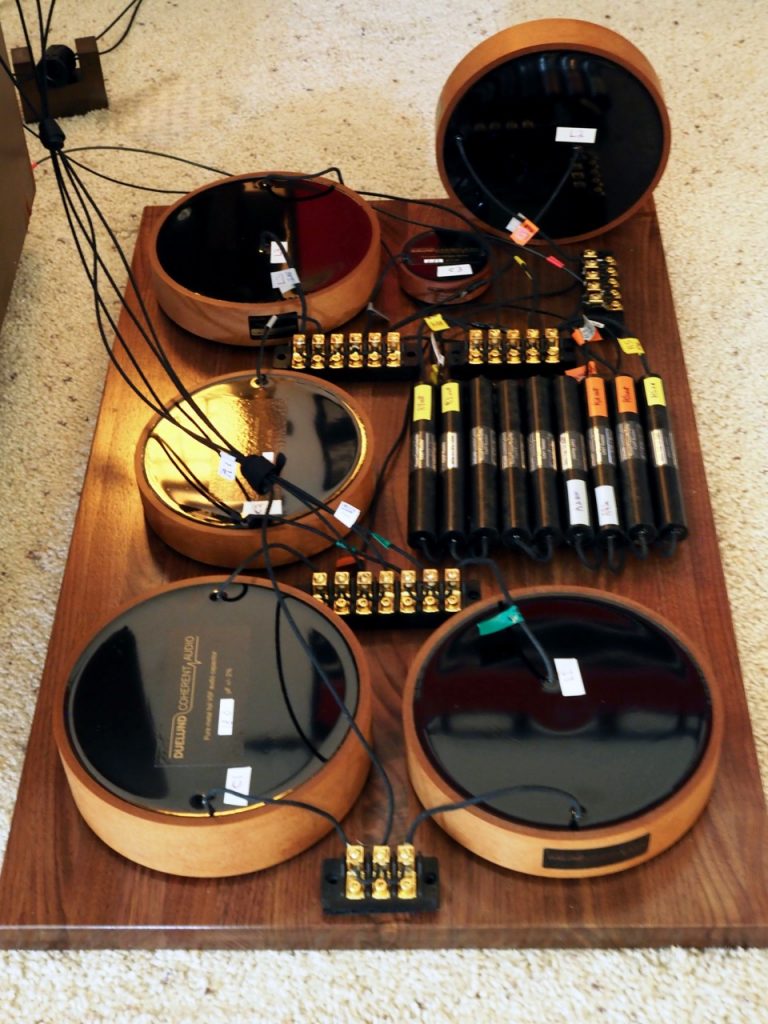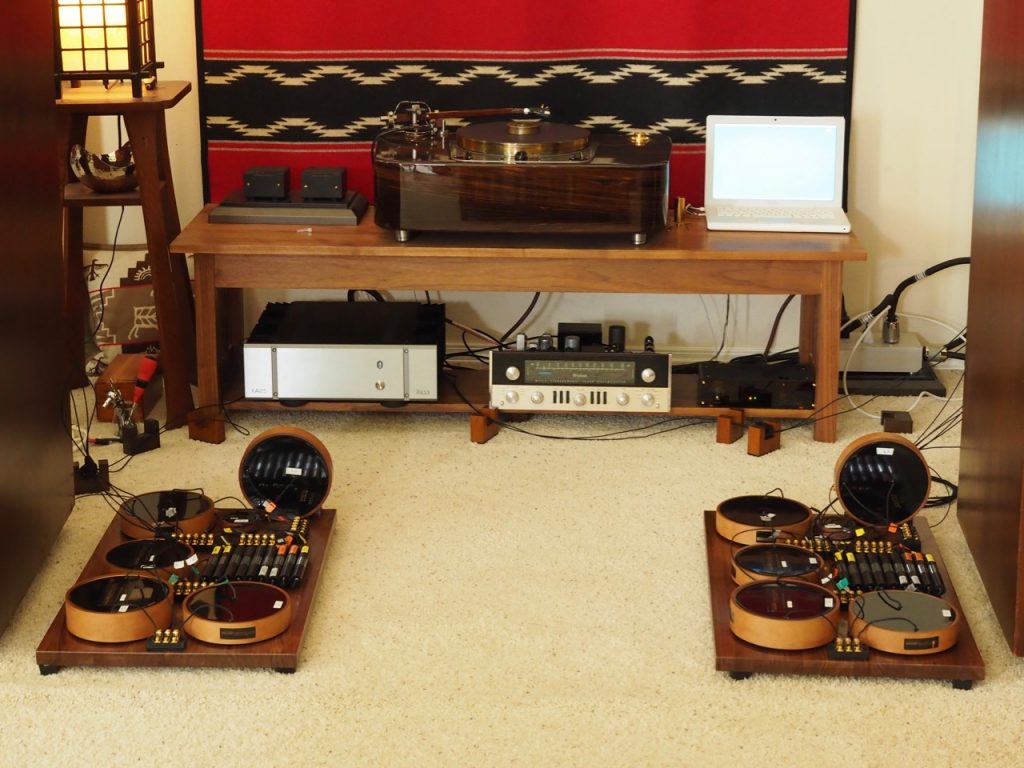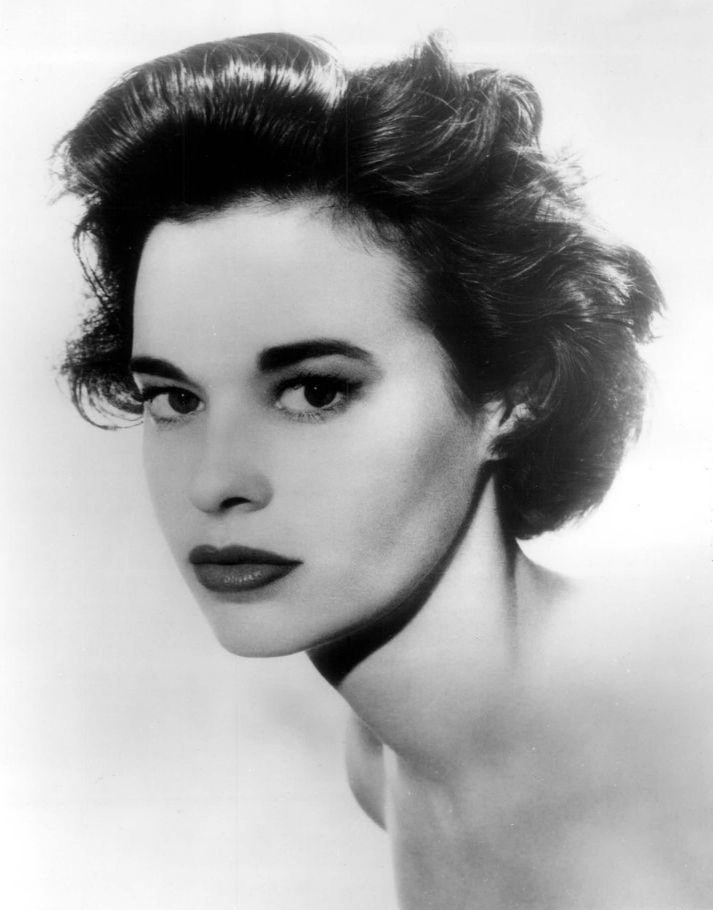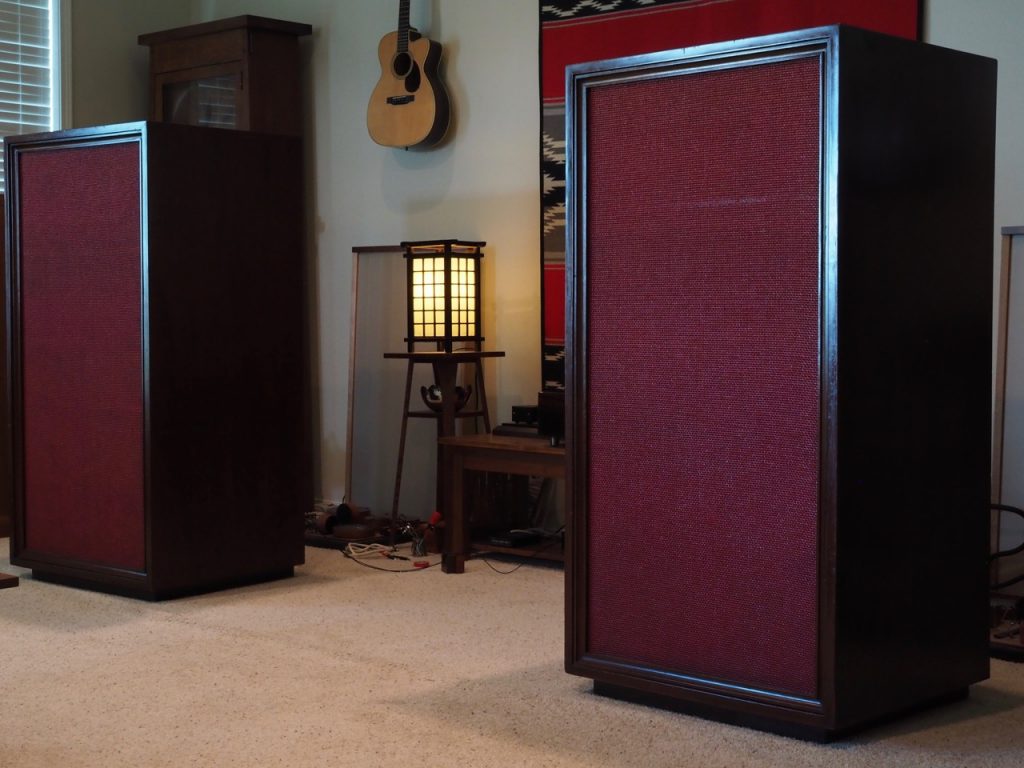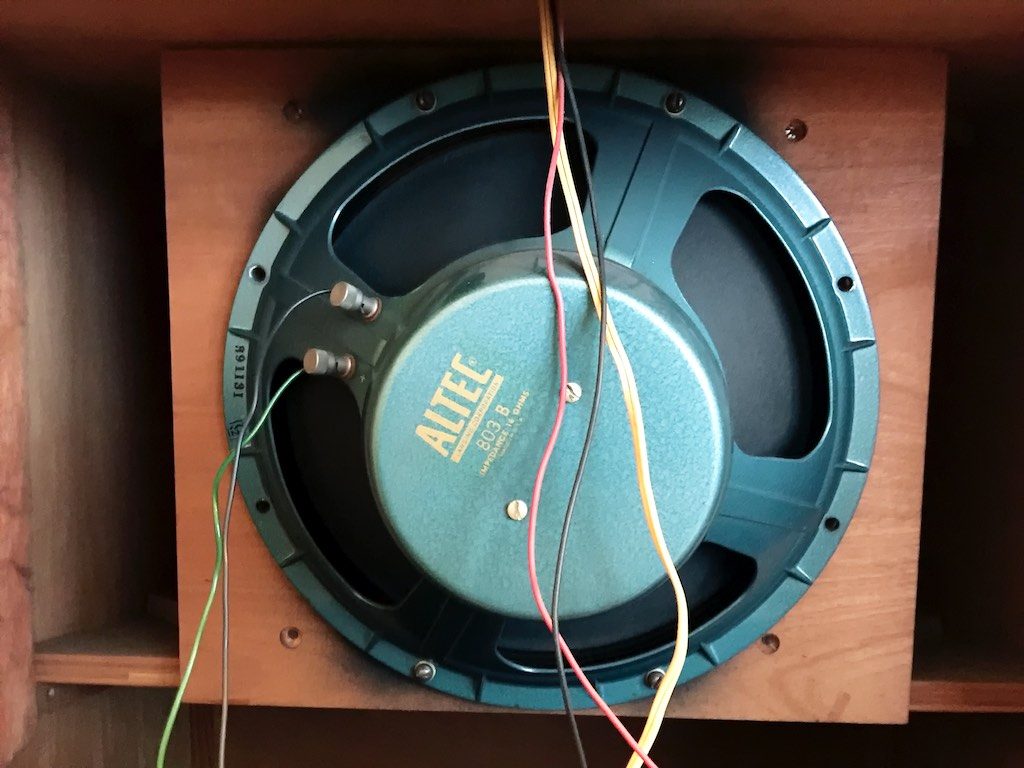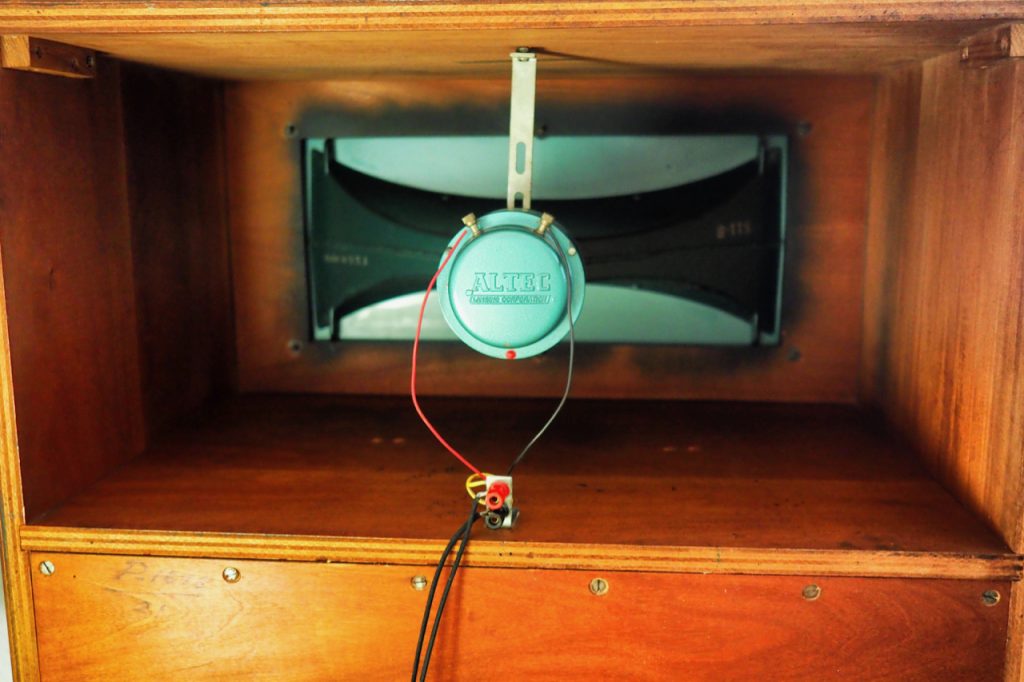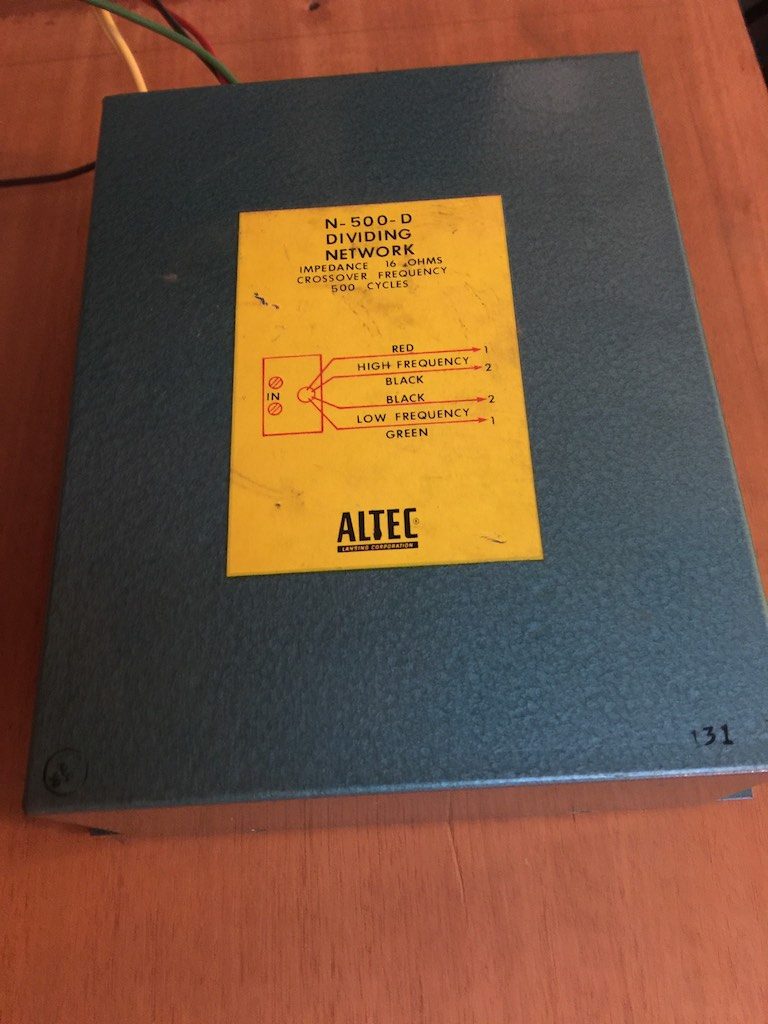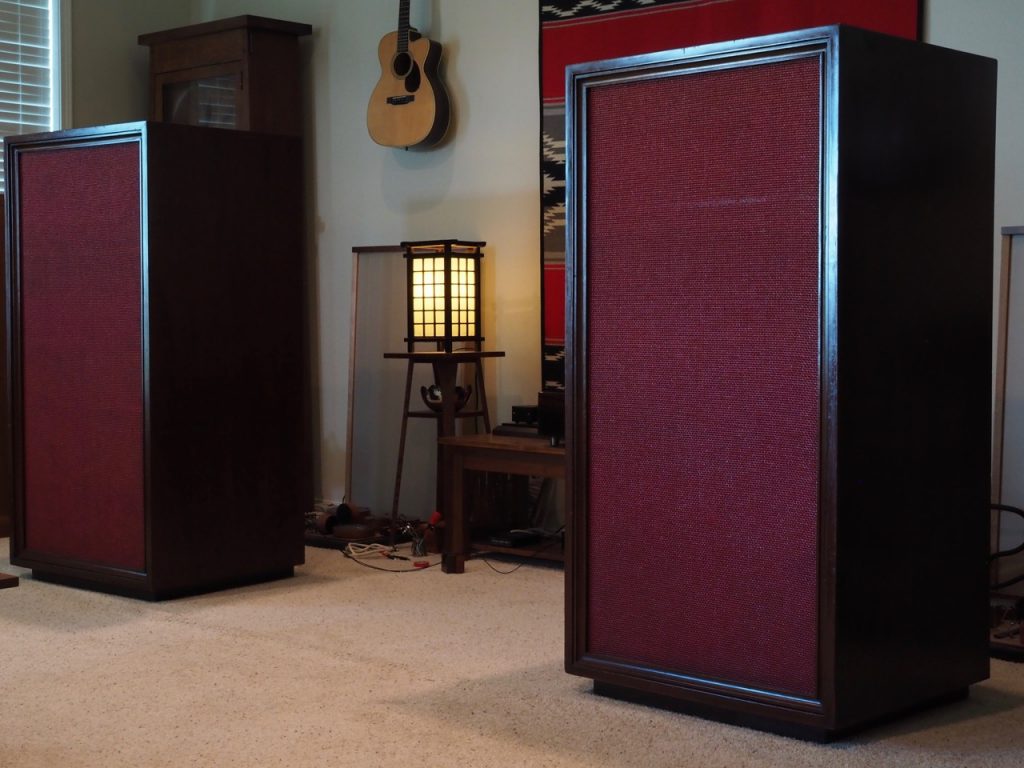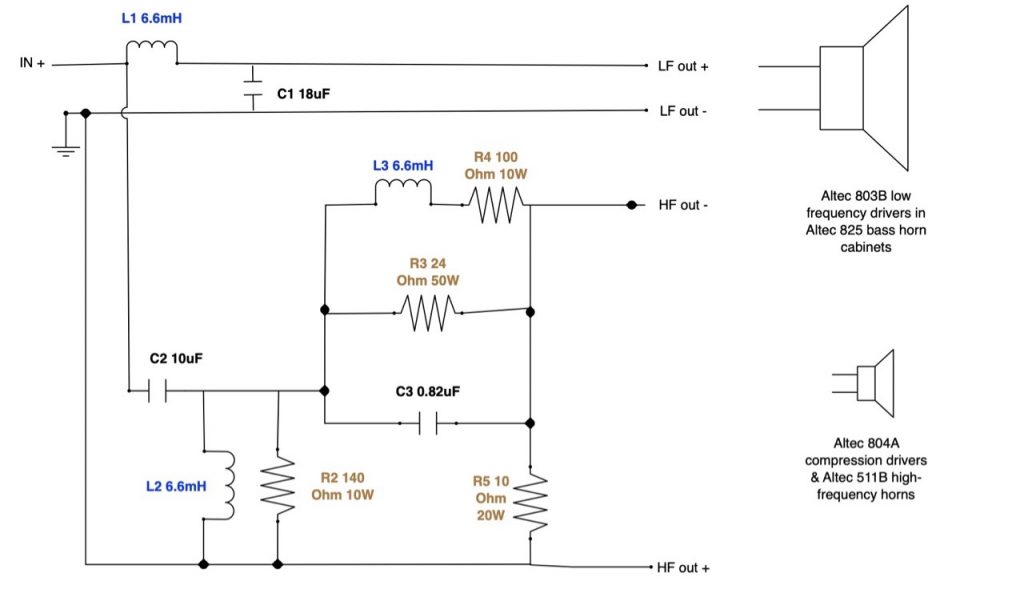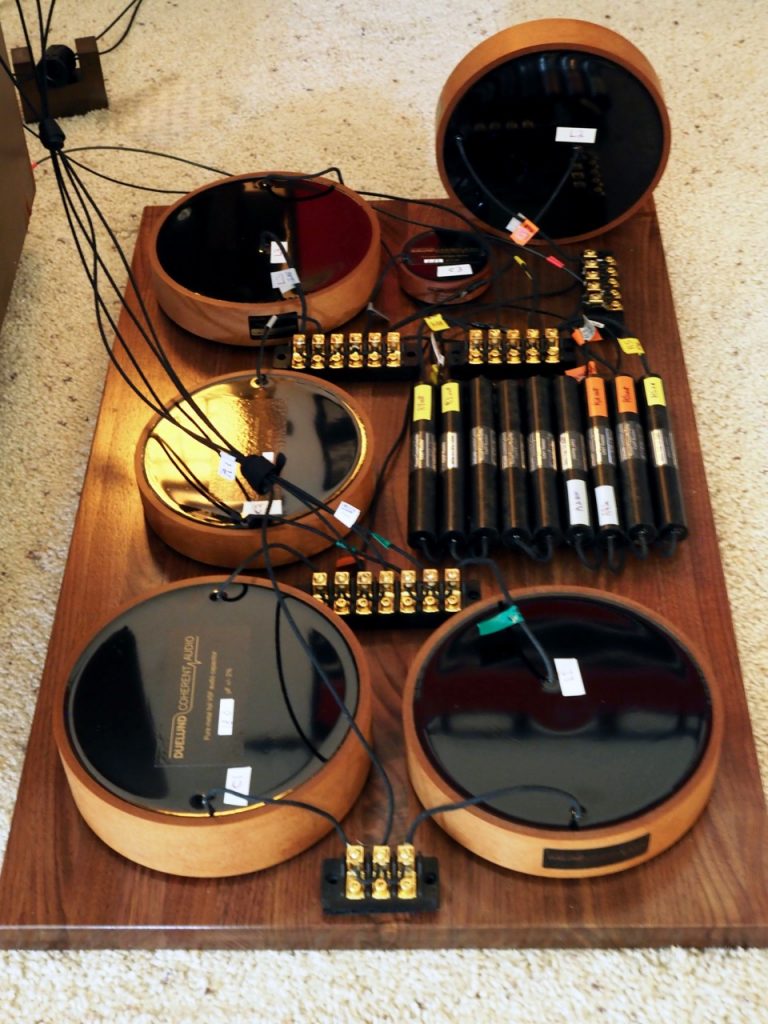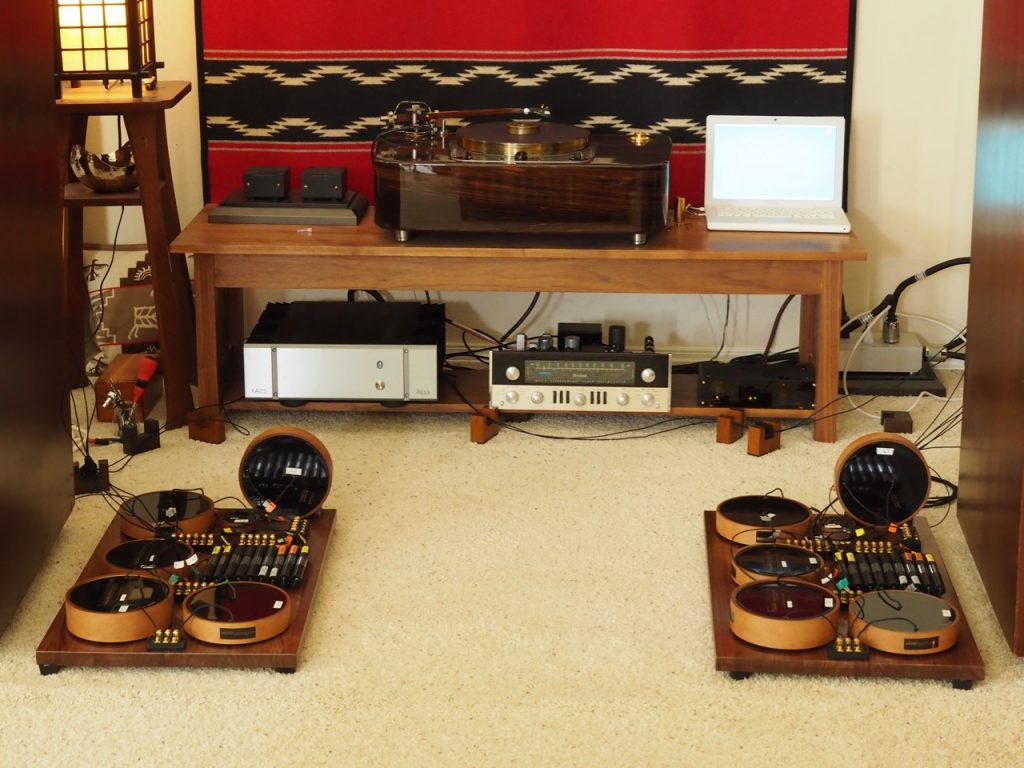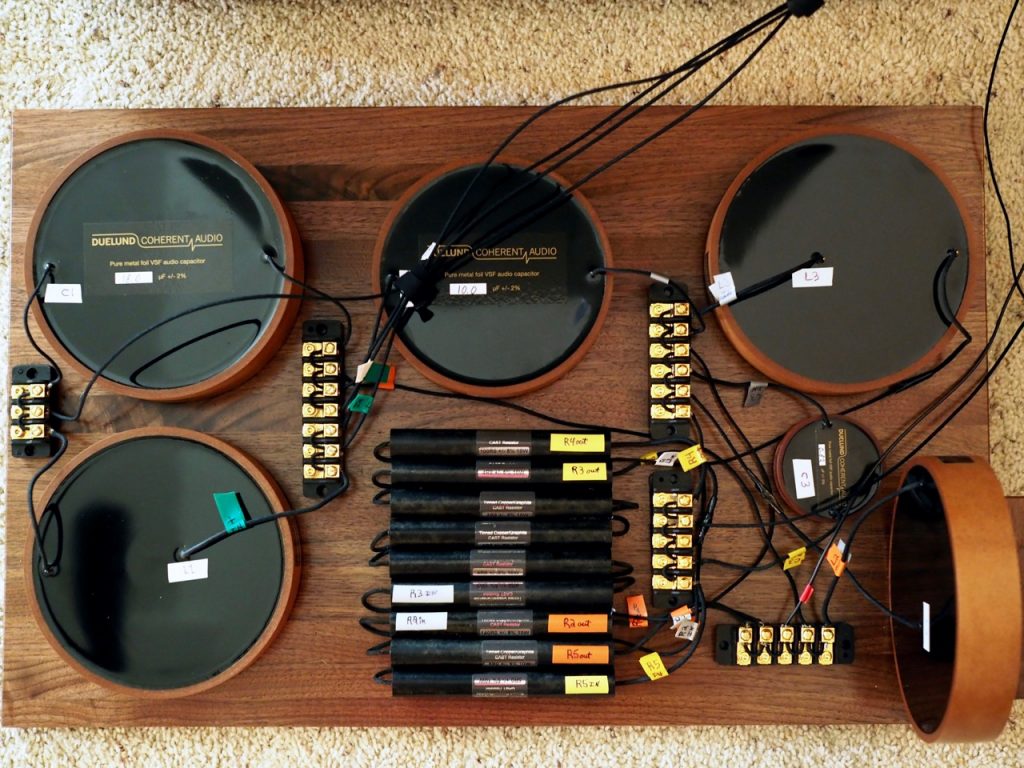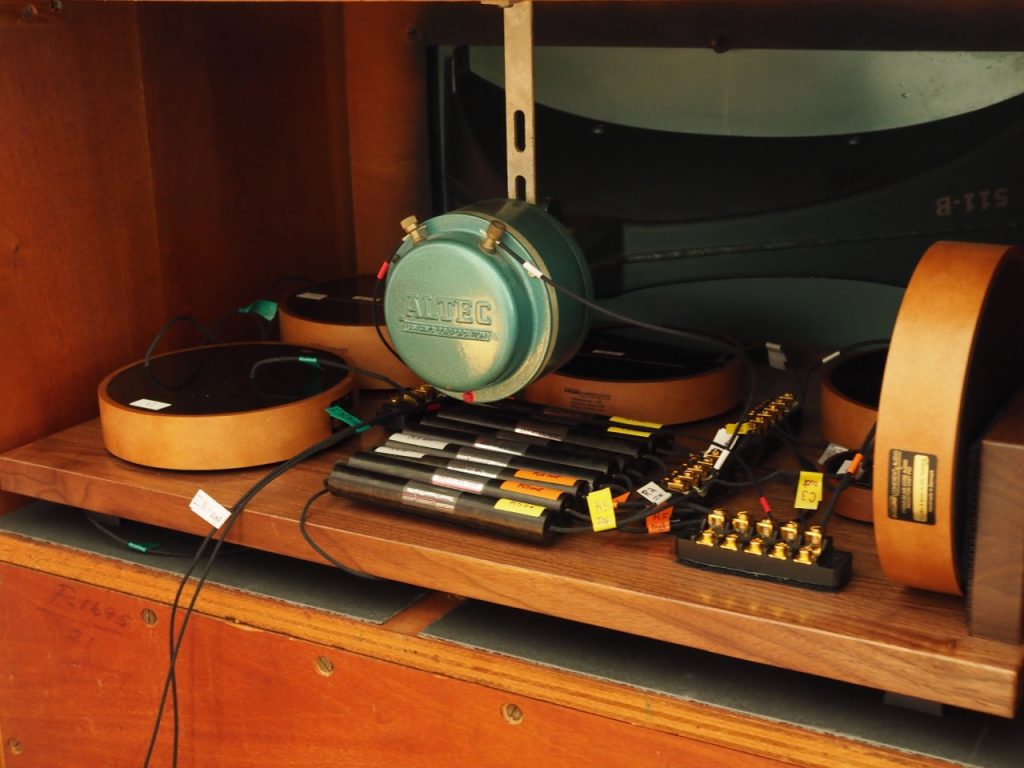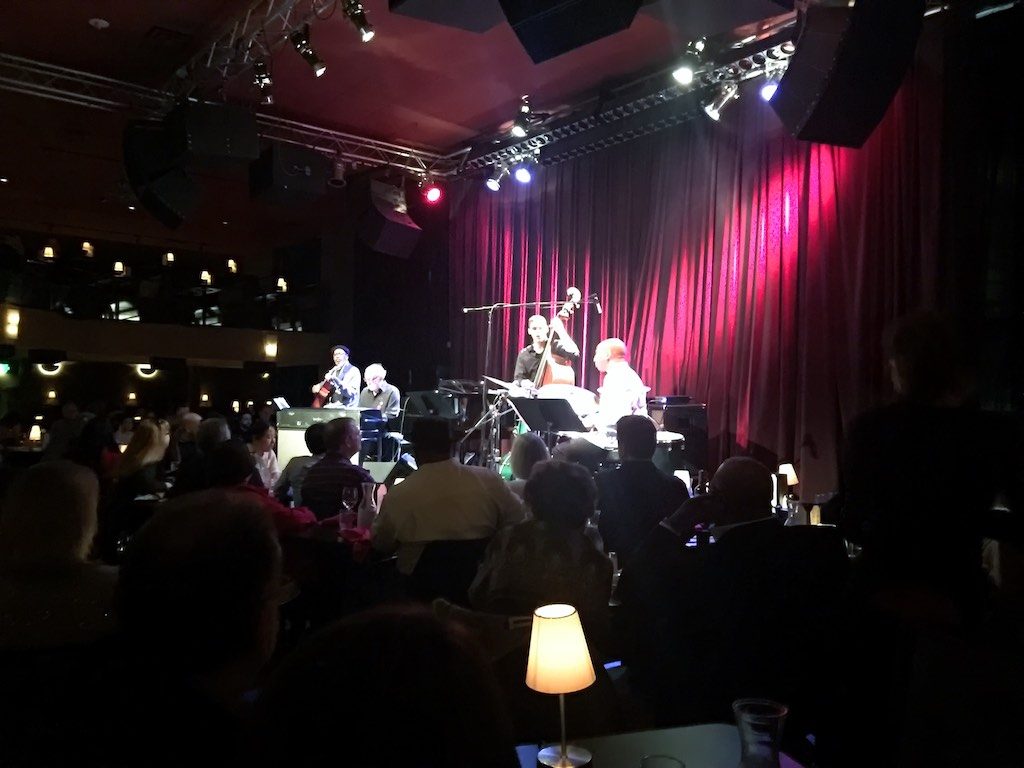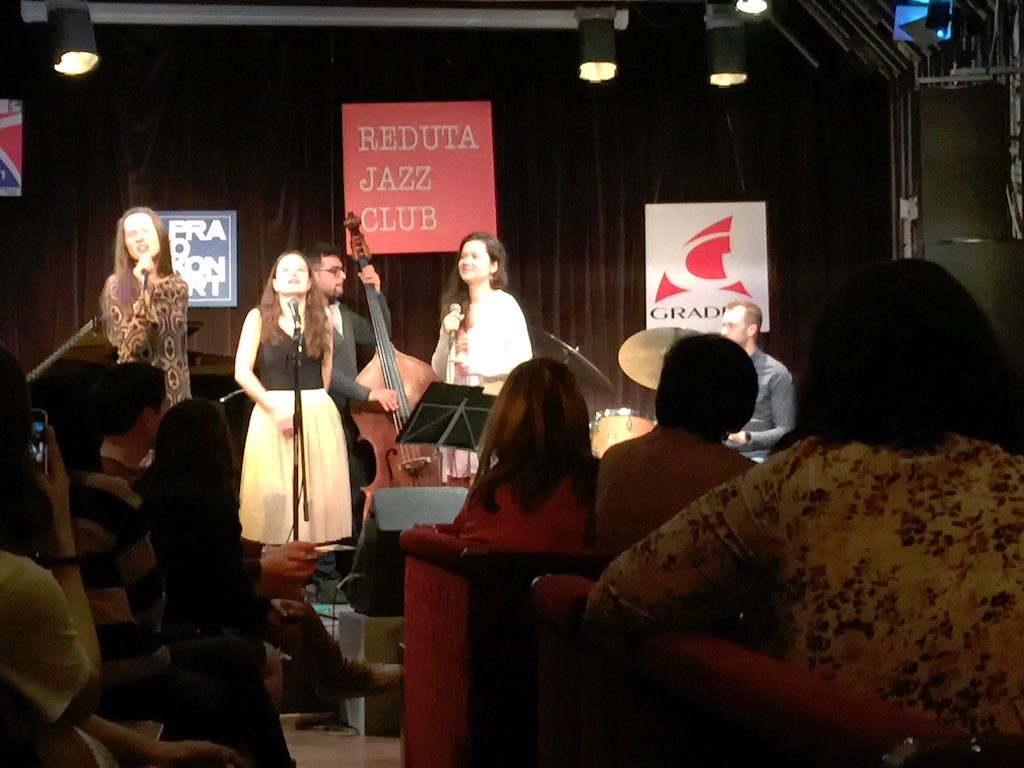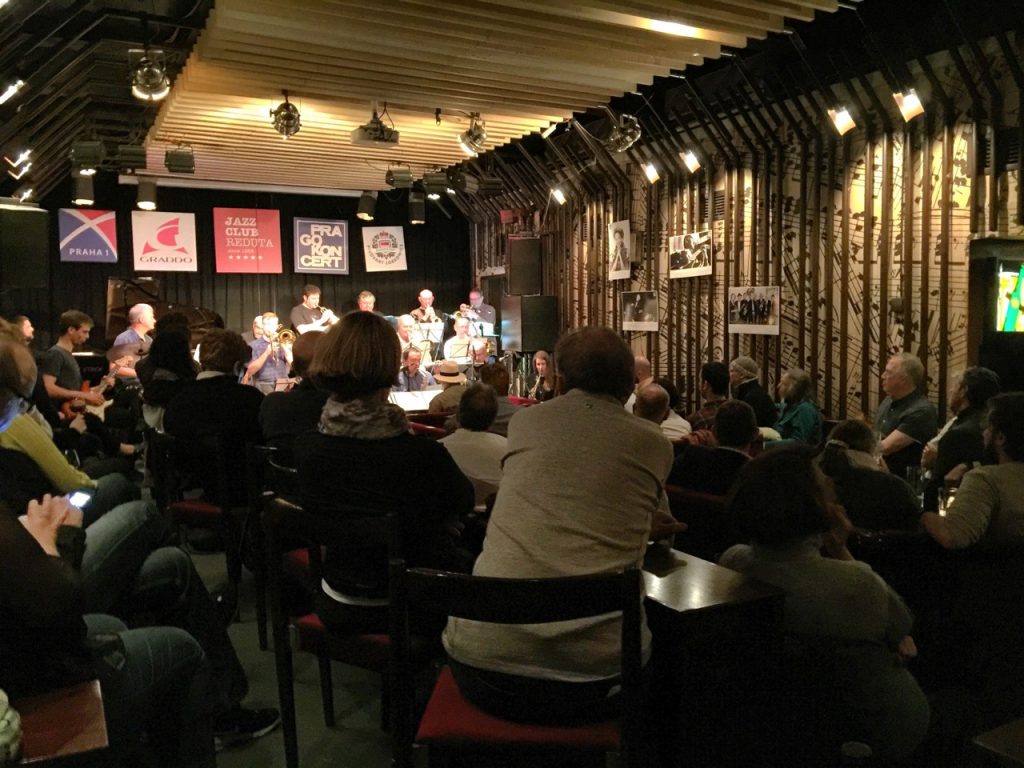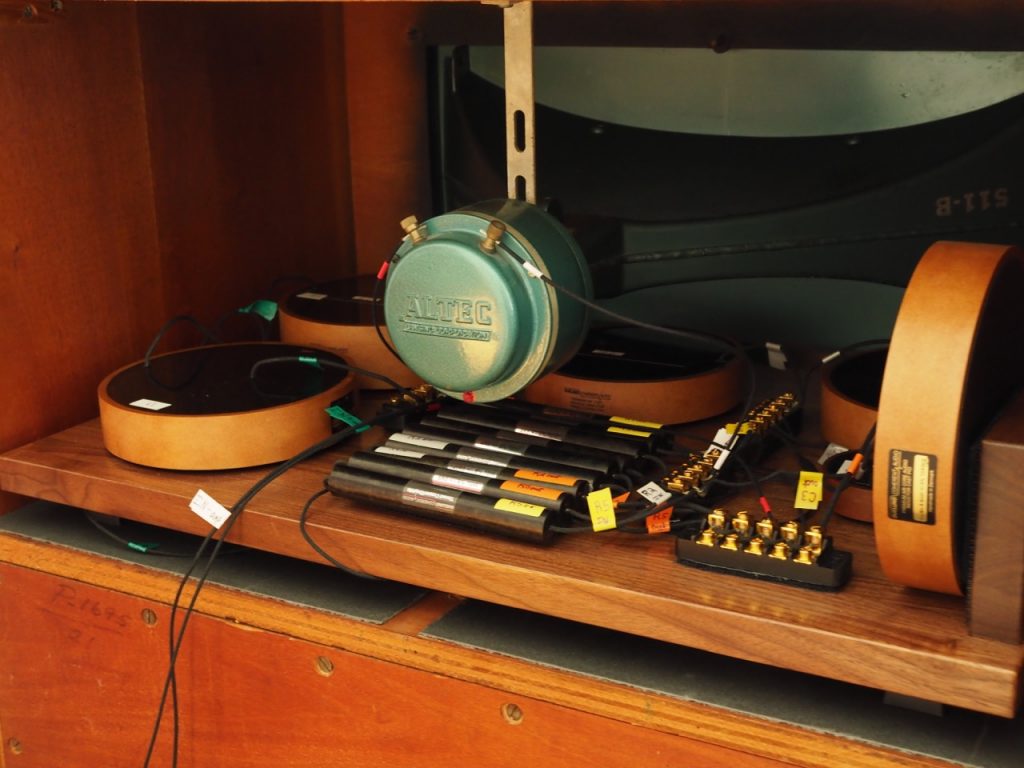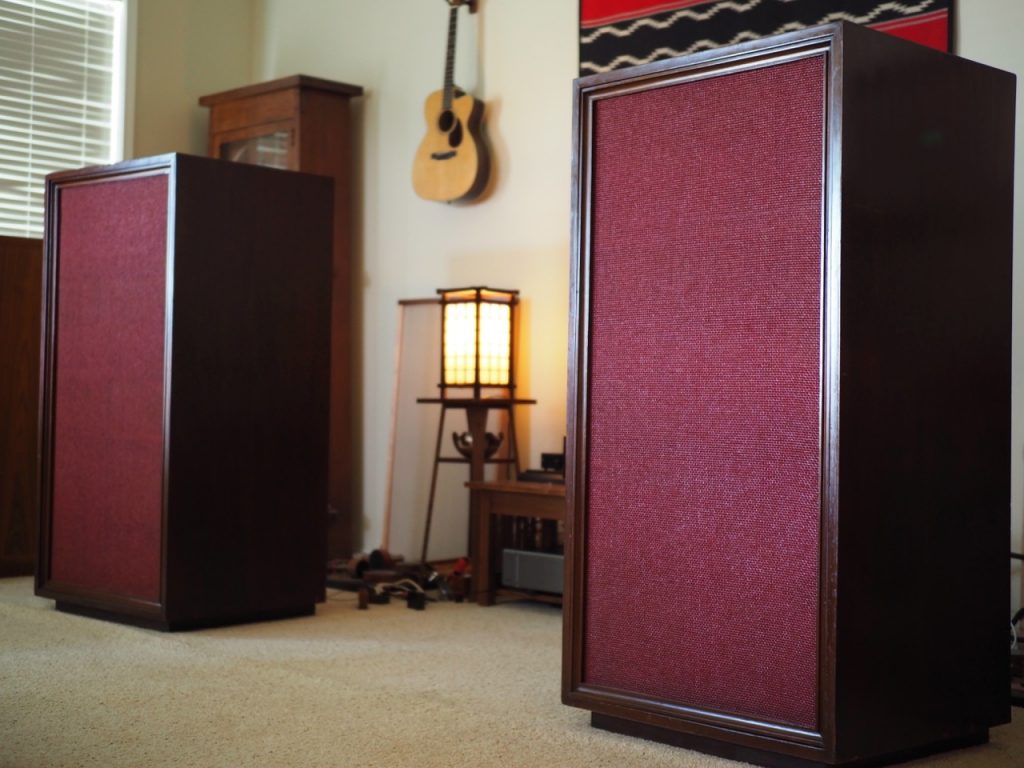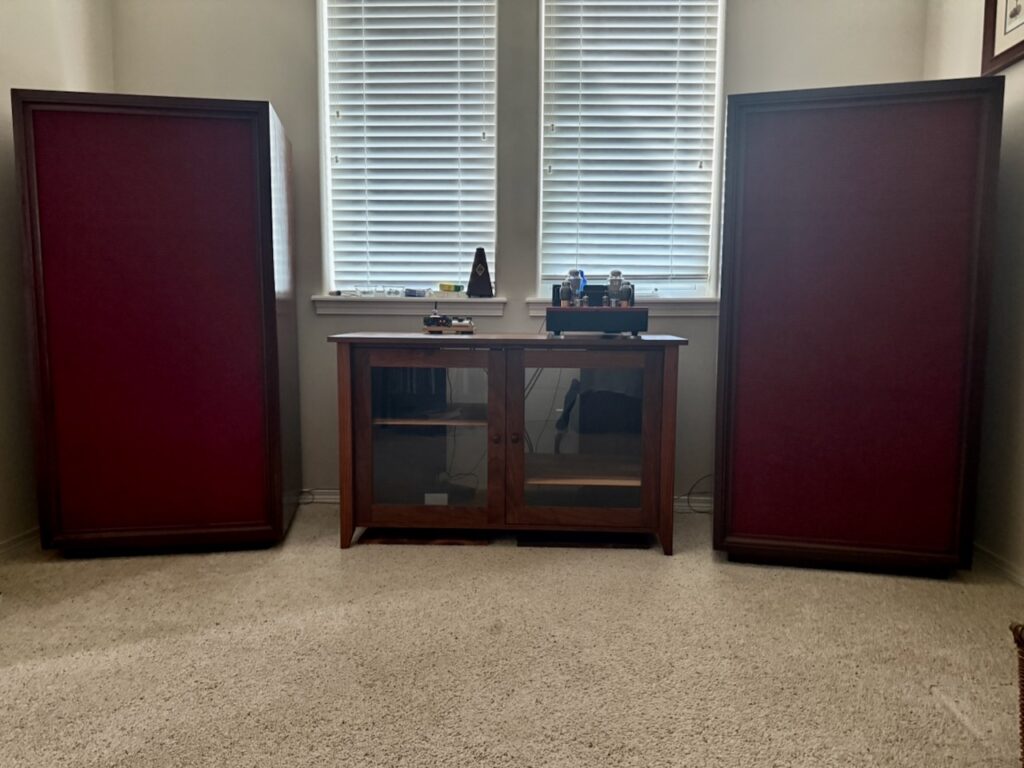♫ "Stokowski" Altec's
This page describes the current state of my "Stokowski" Altec loudspeakers based hifi system upon the conclusion of the Duelund-Altec Project article for Positive Feedback in October 2019 (HERE).
What you'll read here is an extract from that article, but updated to incorporate the system changes that have occurred over time since the Duelund-Altec Project article's publication, so as to reflect the current state of the system.
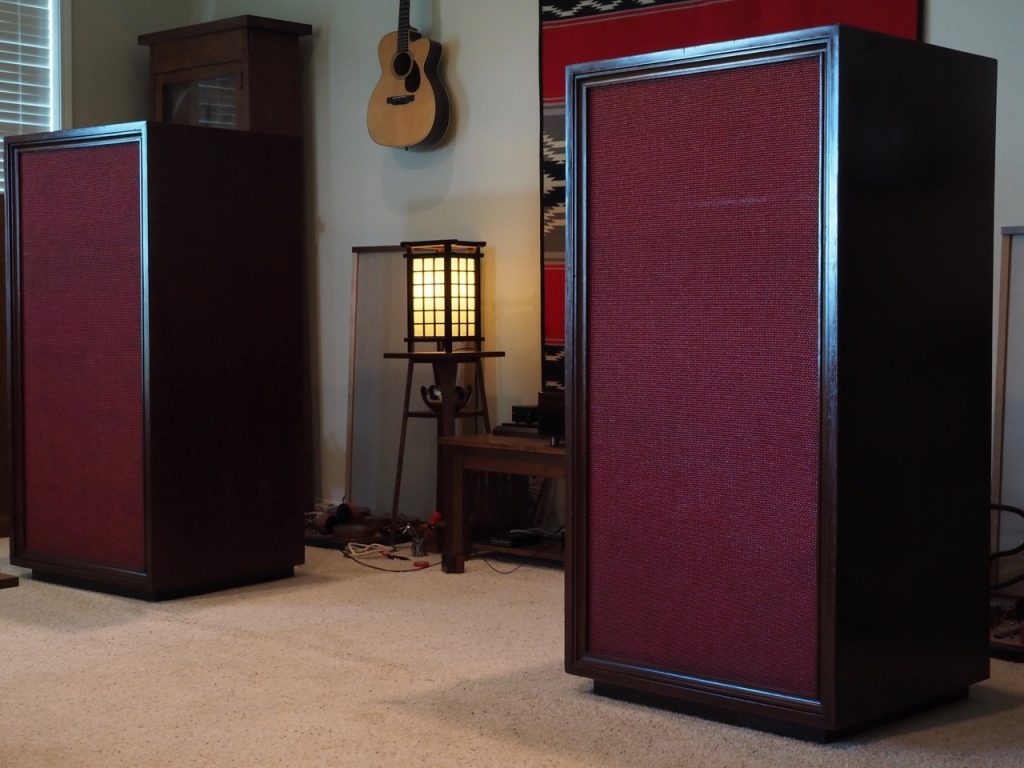
These vintage Altec loudspeakers are historically important vintage Altec loudspeakers that were custom made for the domestic use of conductor Leopold Stokowski in the early 1960s (hereinafter referred to as the "Stokowski" Altec's), that were updated with the latest state-of-art Duelund Coherent Audio CAST tinned-copper capacitors, inductors, and resistors in a Jean Hiraga inspired crossover circuit (photo below).
The resulting combination of the state-of-art Duelund CAST tinned-copper components with the early 1960s custom vintage Altec loudspeakers (photo below) has completely reset my expectations for what is possible for loudspeaker performance in terms of musicality, live-like musical realism, emotional impact, and the natural presentation of imaging, soundstage, sense of recorded acoustic, as well as the other visuospatial artifacts of the recording process.
Honestly, I can't think of any crossover-loudspeaker combination I'd rather own at any price that is available on the market today—I've enjoyed the results of Duelund-Altec Project that much!
I am sorry to inform you that these are custom one-off vintage Altec loudspeakers and you can't buy a pair of them. However, you could build—or have built for you—a very close analog to the "Stokowski" Altec's should you be inspired to do that, but let me give you fair warning that in real-world terms it would be relatively expensive to do so.
After having lived with the Duelund-Altec Project loudspeakers for a while now, I can tell you that even though the cost of duplicating them would be relatively expensive, if your tastes and musical priorities run similar to mine, I think you would find the result to be eminently satisfying, the money well-spent, and likely they would be the last pair of loudspeakers that you would ever want to own.
You might wonder why one would build such exotic and high-performance crossovers for an almost six decades old pair of vintage Altec loudspeakers?
It's a fair question.
There're two reasons, really, with the first reason being the high-performance nature of these particular vintage Altec loudspeakers themselves, with the second reason being these vintage Altec's are historically important because of the person they were custom made for, famed conductor Leopold Stokowski (April, 18, 1882 to September 13, 1977).
Those two reasons are inextricably combined in the high-performance nature of these vintage Altec loudspeakers.
Let's first talk about the high-performance nature of these vintage Altec loudspeakers in and of themselves.
Most people don't usually connect the terms "vintage" with "high-performance," assuming instead that these two terms must be mutually exclusive. After all, don't the latest models of hifi offerings being produced for audio enthusiasts today represent the maximum attainable performance by leaps and bounds over the vintage equipment?
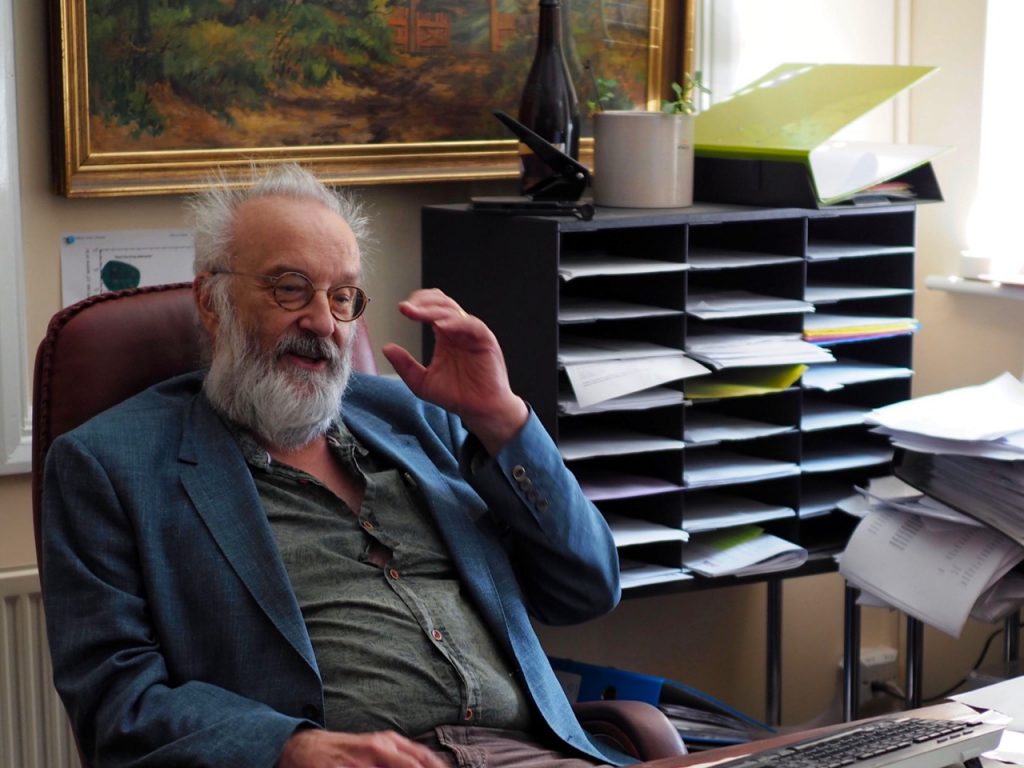
Peter Qvortrup of Audio Note UK.
Peter Qvortrup (Audio Note UK), certainly couldn't be accused of falling into the "most people" category on this topic, as I've discussed in blog posts at Jeff's Place related to my recent visit with Peter in Brighton, England.
Peter says that the peaks of high-performance developments in the recording and audio arts occurred early in audio and recording history, with the performance peak for recording quality and software quality occurring from approximately 1950 to 1960, the performance peak for amplification quality occurring from approximately 1920 to 1930, and the performance peak for loudspeaker quality occurring in the late 1930s, which was led by cinema sound research & development.
Peter also says since those peak performance periods in hi-fi history, as time has progressed we have seen diminishing returns in performance advancements, or even diminishment in overall performance, in the recording and audio arts.
So that's not to say that there isn't some truly great audio gear being produced today, there certainly is, but rather that the advancements in performance in gear being produced today are present in diminishing returns – and the magnitude of those advancements might not be as great as many enthusiasts perceive—compared to the peaks of performance that occurred historically.
I certainly share Peter's perceptions about the peak performance periods of the audio arts based on my own experiences with vintage hifi gear, or obviously I wouldn't have engaged in this project utilizing the ultra-high-performance Duelund CAST tinned-copper components in the vintage "Stokowski" Altec loudspeakers and written this article about it.
I think I would expand Peter's range for the performance peak of loudspeaker quality a wee bit, and suggest a range from the late 1930s to the early 1960s, although it could be argued that those advancements from the late 1930s to the early 1960s are largely refinements of what was done in the late 1930s.
Nevertheless, the main point is still that this period of time was a period when huge efforts and financial resources were being poured into advancing cinema sound performance through research & development by companies like Western Electric and Altec, as well as other cinema sound companies around the world, and represents the peak performance period in the history of loudspeaker research & development.
These custom Altec loudspeakers were built for conductor Leopold Stokowski for listening to music in his home and represent an apogee of sorts for that loudspeaker performance period, and incorporated the accumulated insights, knowledge, and technology development for that period.
Are the "Stokowski" Altec's still high-performance loudspeakers in today's terms?
I would say, yes, they are, and as a case in point, when my good friend Chad (above) was visiting me in September 2018, we set up the "Stokowski" Altec's in the positions normally reserved for my hot-rodded Tannoy Westminster Royal SE loudspeakers, which are an example of very high-performance loudspeakers with their external Duelund CAST crossovers.
After getting the Altec's in place, Chad said he thought the vintage "Stokowski" Altec's—even with their stock N-500-D Altec crossovers—actually exceeded the performance of my heavily modified and "Duelund-ized" Westminsters, and as I would find out in later listening sessions with other audio enthusiasts, that they were about equally split on preferring either the performance of the hot-rodded Westminsters or the custom vintage "Stokowski" Altec's.
My observations are that the Westminster's Dual Concentric drivers are more coherent, the high-frequency driver & horn combination are more resolving, and the Westminster's extend lower in the bass, but the vintage "Stokowski" Altec's have an edge in overall musicality, and a greater sense of live-like musical realism.
Finding out that these nearly six decades old custom vintage "Stokowski" Altec's could go pretty much toe-to-toe with my heavily hot-rodded Tannoy Westminster Royal SEs was certainly a wake-up call for me, and underscores the validity of what Peter has said about the peak of loudspeaker performance quality being led by cinema sound research & development by companies like Altec (and others) in the early days of cinema.
Leopold Stokowski at Carnegie Hall 1947 (public domain photo)
Dr. Leopold Stokowski
Now let me tie these custom Altec loudspeakers back to their original owner, the famous conductor, Leopold Stokowski, and fill in the gaps as to why that matters with respect to their performance.
The "Stokowski" Altec's were custom built loudspeakers for Dr. Leopold Stokowski (April 18, 1882 – September 13, 1977), during the time he lived in New York and was conducting the American Symphony Orchestra.
It is fairly common knowledge that Leopold Stokowski was one of the world's leading conductors during his lifetime, and conducted numerous symphony orchestras, including of the Cincinnati Symphony Orchestra, the Houston Symphony Orchestra, the NBC Symphony Orchestra, the New York Philharmonic Symphony Orchestra, the Philadelphia Orchestra, and the Symphony of the Air, as well as others.
Leopold Stokowski was a remarkable and creative individual and musician, who was also very interested in the recording and reproduction of music, and had enormous influence upon the world of music, film, recording, audio engineering, and even culture, during his lifetime.
For example, Leopold Stokowski set American culture abuzz by hiring talented women and musicians of color for his orchestras during a time when orchestras were almost exclusively composed of white males.
Gloria Vanderbilt in 1959 (Public Domain Photo)
His marriage to heiress and socialite Gloria Vanderbilt (above, the mother of television personality Anderson Cooper), and his liaison with film star Greta Garbo (below), set the media world abuzz about his high-profile relationships and celebrity lifestyle.
Greta Garbo (Public Domain Photo)
Another fascinating aspect of Leopold Stokowski's life—which is particularly relevant to his Altec loudspeakers—was that early in his career he became interested in the technical aspects of the recording and playback of music, something that most conductors of the time eschewed.
To aid Leopold Stokowski in his interests, Professor Charles Weyl at the University of Pennsylvania created a tailored curriculum for him that focused on what he needed to know about acoustics and electrical engineering in order to more effectively participate in guiding the technical activities of the audio engineering that he had become involved in.
The University of Pennsylvania eventually awarded Leopold Stokowski an honorary doctorate for his accomplishments in music, audio engineering, and film.
Leopold Stokowski worked closely with recording engineers during the acoustic horn recording era (1917-1924), the electrical recording era (1925-1940), and the "modern" analog recording era until his death (1941-1977), always striving for improved fidelity of recorded music. He heard it all.
Leopold Stokowski was very involved in advancing the recording and playback of music and worked closely with audio engineers from Altec Lansing, Bell Labs, Disney, RCA, and others, to advance the recording arts for records, film, and radio broadcast.
Leopold Stokowski loved experimenting with recording and playback technology and was involved in the development of multi-track recording used in some of the first stereo recordings.
He also collaborated with RCA in the use of a multi-track film recorder for the movie 100 Men and a Girl, in which Stokowski played a speaking part, and also with the Fantasound multichannel sound system developed by RCA and Disney engineers for the famous animated movie Fantasia.
So, have you ever wondered what a famous conductor like Dr. Leopold Stokowski—who was not only a brilliant conductor and musician, but was involved in every aspect of research and development advancements in film, recording, and the audio arts during their peak performance advancement periods—would build as his own ultimate loudspeakers for his personal home listening?
Well, you don't have to wonder, as you are looking at them in the above photo—the "Stokowski" Altec's.
The "Stokowski" Altec's are rather large loudspeakers (60 inches high by 30 inches wide by 26 inches deep), with Altec drivers, horns, and crossovers enclosed in truly massive custom wood cabinets, and fitted with burgundy grill cloth.
You can get an idea of the "Stokowski" Altec's size in the photo below where I am polishing them with some Kramer's Best Antique Improver prior to the start of the Duelund-Altec Project—they're even bigger than my Tannoy Westminster Royal SE loudspeakers!
The "Stokowski" Altec's were built very solidly and professionally, with everything fitted perfectly together.
These are vintage loudspeakers—they're almost six decades old now—and so their cabinets have accumulated a few scuffs and scrapes over the years, but still they are in very nice cosmetic condition considering their age, and the drivers, horns, crossovers and cabinets are in perfect operational condition—a testimony to the impeccable quality of Altec products of that period.
The cabinets that enclose the "Stokowski" Altec's provide substantial reinforcement for the 825-style bass horns that are incorporated into their cabinetry.
There is a divider panel between the low- and high-frequency horn sections of the cabinets—which would be an 825-style bass horn's top panel—that acts as a massive cross-brace to the cabinet's sidewalls.
The rear of the cabinet is broken into three segmented panels with further cross-bracing for the sidewalls, whereas the production 825 cabinet is a large, single, screw-mounted panel with no cross-bracing.
The heavily braced front panels are inset into the oversized sidewalls, so they too are acting as additional bracing, and the mounting panel for the 511B is also acting as yet another cross-brace.
All of that bracing and cabinetry adds up to a rigidity and massiveness for the "Stokowski" Altec cabinets that is off the charts compared to the regular production 825 bass horn cabinets like I have in my Altec A5 Voice of the Theatre loudspeakers.
The Stokowski Altec's components complement are 803B 16-Ohm bass drivers housed in the massively braced 825-style bass horn cabinets, Altec 804A 16-Ohm compression drivers that are mounted on Altec 511B horns and enclosed in their own dedicated high-frequency enclosure of the cabinets, and the Altec N-500-D crossovers are mounted inside the low-frequency cabinets.
The 803B low frequency driver is described in the Altec literature as, "The Altec 803B is a 15-inch low frequency loudspeaker of professional quality, chosen to complement the finest broadcast and recording studio monitor systems (such as the A7 and A7-500) in addition to providing the critical listener with superb bass reproduction for all wide-range public address, sound reinforcement and theatre or auditorium systems."
"Utilizing heavy Alnico V permanent magnets (2.4 lbs.), rugged, die-cast frames, edge-wound copper ribbon voice coils of the largest practical diameter (3"), and exceptionally compliant cone suspension, these LF transducers combine the advantages of long-term operation with unparalleled response throughout the entire audible bass frequency range (20-1,600 cycles)."
The Altec 803B low frequency driver has a continuous power rating of 30W, a frequency response of 20-1,600Hz, a sensitivity of 99dB (SPL at 4" from 1W), and 114dB (SPL at 4" from 30W).
The Altec 803B low frequency driver has an impedance of 16 Ohms, the cone resonance is 25 Hz, the Alnico V magnet flux density is 12,000 Gauss, the frame (basket) is structurally-reinforced cast aluminum, the cone is molded fiber, the cone suspension is a high-compliance cloth surround with mechanical resistance, the voice coil is edge-wound copper ribbon, the diameter is 15 1/8 inches (7" deep), and the weight is 17.5 pounds.
Up top are the Altec 804A 16-Ohm compression drivers mated to Altec 511-B horns (above).
The Altec 804A and Altec 802D compression drivers are essentially the same design, and are shown together in Altec literature.
The Altec 804A / 802D both use large diameter (1.75") aluminum ribbon edge-wound voice coils coupled to a large (2.25") aluminum diaphragm having tangential compliance. Both have a mechanical phasing plug with two exponential acoustic slots, which provides the proper phase relationship from sound emanating from the center & outer edges of the diaphragm and voice coil assembly, to give maximum high-frequency reproduction and a smooth overall response.
Like the 803B low frequency drivers, both the Altec 804A / 802D are rated for 30W. The Altec 804A / 802D frequency response is 500Hz to 22,000Hz, voice coil diameter is 1.75", impedance is 16 Ohms, and diameter is 4.5".
The primary difference is their magnets, as the 802D uses a 1.2 lbs., 15,250 Gauss magnet and the 804A uses a 13 oz. 13,000 Gauss magnet, which reflects their intended use as compression drivers for sound reinforcement in large spaces with high ambient noise levels (802D), or smaller spaces, like home listening rooms or smaller recording studios with moderate ambient noise levels (804A).
The Altec 804A compression driver is optimized for loudspeakers, "... located in non-reverberant space having moderate ambient noise levels, the Altec 804A driver proves a perfect match (Such conditions would be analogous to the average listening room or smaller broadcast and recording studio)", and pressure sensitivity is rated at 109.5dB at 1W and 124.2dB at 30W.
I actually own examples of both the 802D (in my Altec 832A Corona loudspeakers) and the 804A (in the "Stokowski" Altec's), and they are both extremely good sounding compression drivers.
The Altec 804A compression driver and 511B sectoral horn combination was crossed over at 500Hz with Altec N-500-D crossovers.
Altec describes the 511B sectoral horn thusly, "Exponential expansion and straight throat configuration ensure uniform control of the sound dispersion pattern—90º horizontal by 40º vertical—and exacting reproduction of the middle and high frequencies."
The 511B sectoral horn weighs 17¾ pounds, and is 27 cm in height by 60 cm in width by 47 cm in depth.
These Altec loudspeakers were probably built for Dr. Stokowski during the period when their drivers were produced—1961 to 1964—which would put them at 58 to 55 years old, which slightly preceded the official start of production for the Altec A7 Voice of the Theatre loudspeakers, which commenced in 1966, which is what their component selection is most similar to in the Voice of the Theatre loudspeaker product line.
After a long career conducting in America, at age 90, Leopold Stokowski moved back to London in May of 1972 in order to further his recording career, and at that time he gave the loudspeakers to his conductor understudy colleague, who then later put them up for sale, were sold to Jeff (another Jeff), who I bought them from after he and his wife Lynn decided they were too big for their Seattle condo.
As I mentioned earlier, after we got the "Stokowski" Altec's setup in my living room, we listened to a little music while catching up on recent events in each other's lives over a few beers, and we were astounded at how good the "Stokowski" Altec's sounded in my living room with my vintage McIntosh vacuum tube electronics.
One might wonder why Dr. Stokowski went to the trouble of having custom Altec's built for him given the availability of a variety of high-quality domestic Altec loudspeakers at that time, like my own Altec 832A Corona loudspeakers. Or why didn't he just use Altec professional loudspeakers like my Altec A5 Voice of the Theatre loudspeakers?
Well one listen will tell you, as this particular combination of Altec drivers, horns, crossovers, and the massively braced cabinets chosen for the "Stokowski" Altec's sound incredibly good together!
As superb as my vintage Altec 832A Corona loudspeakers and my vintage Altec A5 Voice of the Theatre loudspeakers are in their own right (I love them!), the custom "Stokowski" Altec's are significantly better performance-wise, both musically and sonically, and exude an uncanny live-like portrayal of music being played in front of the listener.
It was a real treat to hear what the "Stokowski" Altec's were capable of with my vintage McIntosh MX110Z tuner-preamplifier, vintage MC30 monaural amplifiers, and CTC Garrard 301 turntable, which are hifi components that are similar to what would have been available to Dr. Stokowski during the period they were built, and it gave me a good sense of what Dr. Stokowski would have heard in his own Fifth Avenue apartment.
Considering Leopold Stokowski's enormous influence upon the world of music, film, recording, and audio engineering during his lifetime, I was fascinated by hearing what his reference loudspeakers could do compared to contemporary high-performance loudspeakers like my Westminster Royal SEs, and they didn't disappoint!
When participating in the development of audio equipment, Dr. Stokowski refined their performance by comparison to live performances of the symphony orchestras he conducted, even doing live A-B tests in an adjacent room with his orchestra playing, and refining their audio performance based on what his talented and informed ears heard.
Considering Dr. Stokowski's methodology for developing audio equipment based on what he heard in live performances of his own orchestras, it's no wonder these nearly six decades old custom loudspeakers of Dr. Stokowski's are competitive with the best loudspeakers of today in terms of their live-like musicality and sonics, and are more than competitive in the way they provide a sense of musical engagement from an emotional standpoint.
The listening revelation that these grand old custom Altec's of Dr. Stokowski's were so very good in terms of musicality, sonics, and emotional impact, made the Duelund-Altec Project a particularly exciting audio adventure to be a part of!
The Duelund CAST Tinned-Copper Crossovers for the "Stokowski" Altec's
The vision for the Duelund-Altec Project was to replace the stock N-500-D Altec crossovers of the "Stokowski" Altec's with crossovers built utilizing the latest Duelund CAST tinned-copper components in a Hiraga-inspired circuit, both to demonstrate the Duelund CAST tinned-copper crossovers' performance, as well as to find out how much the Altec's already excellent musical & sonic performance could be enhanced by doing so (it was a dramatic improvement, as you no doubt have gleaned from this post).

Low-Frequency Circuit
- One 6.6mH Duelund CAST tinned-copper inductor at L1.
- One 18uF Duelund CAST tinned-copper capacitor at C1.
High-Frequency Circuit
- Two 6.6mH Duelund CAST tinned-copper inductors at L2 and L3.
- One 10uF Duelund CAST tinned-copper capacitor at C2.
- One 0.82uF Duelund CAST tinned-copper capacitor at C3.
- One 140 Ohm 10W Duelund CAST "Jeffistor" resistor at R2.
- "One" 24 Ohm 50W Duelund CAST "Jeffistor" resistor at R3 (comprised of five 4.8 Ohm 10W Duelund CAST "Jeffistor" resistors in series connection).
- One 100 Ohm 10W Duelund CAST "Jeffistor" resistor at R4.
- "One" 10 Ohm 20W Duelund CAST "Jeffistor" resistor at R5 (comprised of two 5 Ohm 10W Duelund CAST "Jeffistor" resistors in series connection).
Leopold Stokowski's vintage Altec's have never sounded so good, I only wish the great conductor was still around to hear them—I think he would approve!
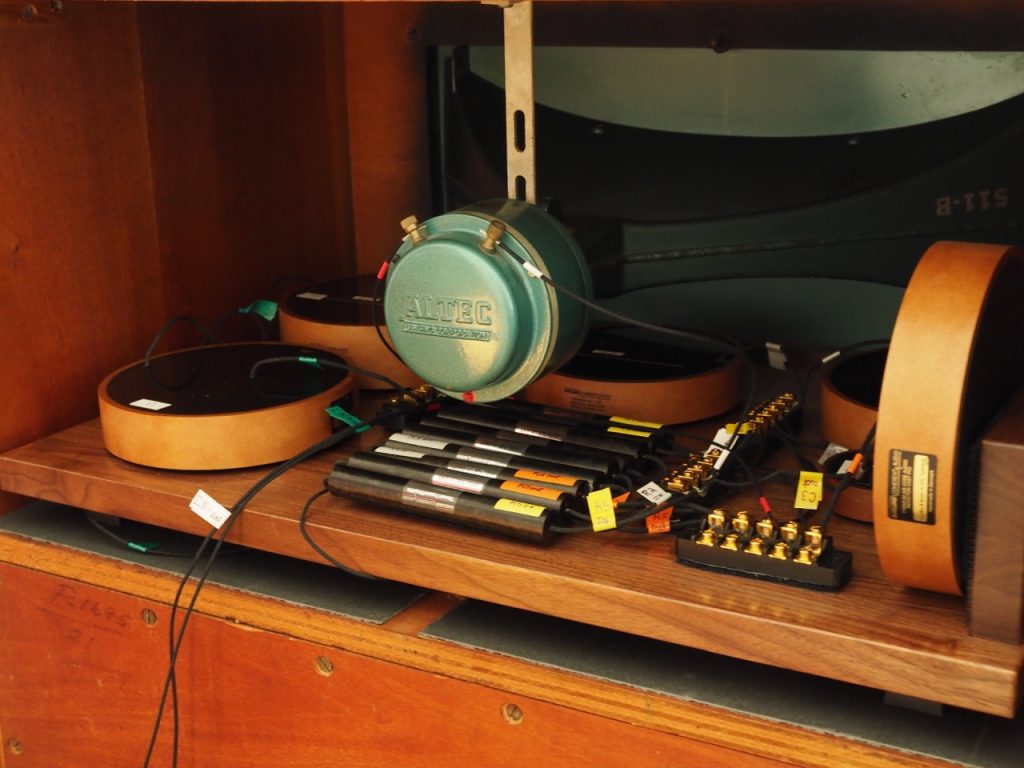
Current State of the Equipment for the "Stokowski" Altec Loudspeaker Based System
For an analog source I used my Classic Turntable Company hot-rodded Garrard 301 turntable in an Artisan Fidelity plinth, with a SPEC AP-UD1 Analog Disc Sheet turntable mat, a Peter Riggle Audio Engineering Woody SPU tonearm equipped with—what else—an Ortofon SPU Classic GM MkII stereo phono cartridge, stepped-up with an Intact Audio SUT that compliments the Ortofon SPU Classic GM MkII, and a Thomas Schick tonearm equipped with a Soundsmith Zephyr Mk III phono cartridge.
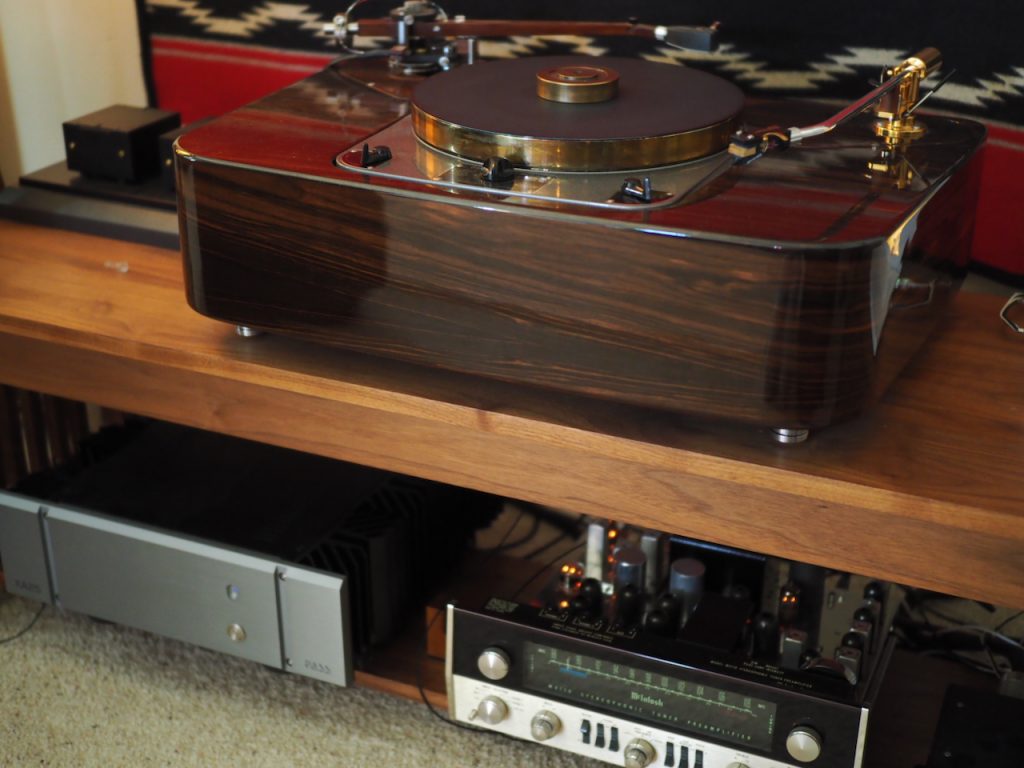
CTC 301 turntable.
For a digital source I use my Apple MacBook to stream digital to my Mhdt Labs Havana vacuum tube USB DA via my DIY Art of Tone tinned-copper USB cable, and for an FM source I used my McIntosh MX110Z tuner-preamplifier.
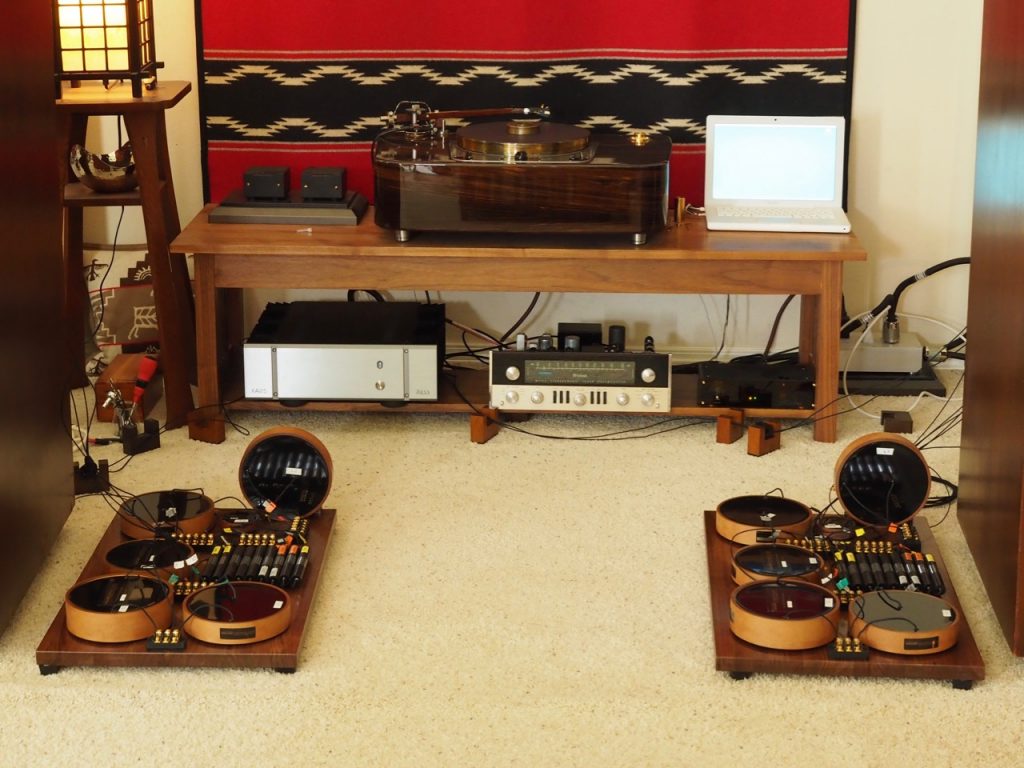
Amplification components currently used in this system include my vintage McIntosh MX110Z tuner preamplifier with vintage McIntosh MC30 monaural amplifiers.
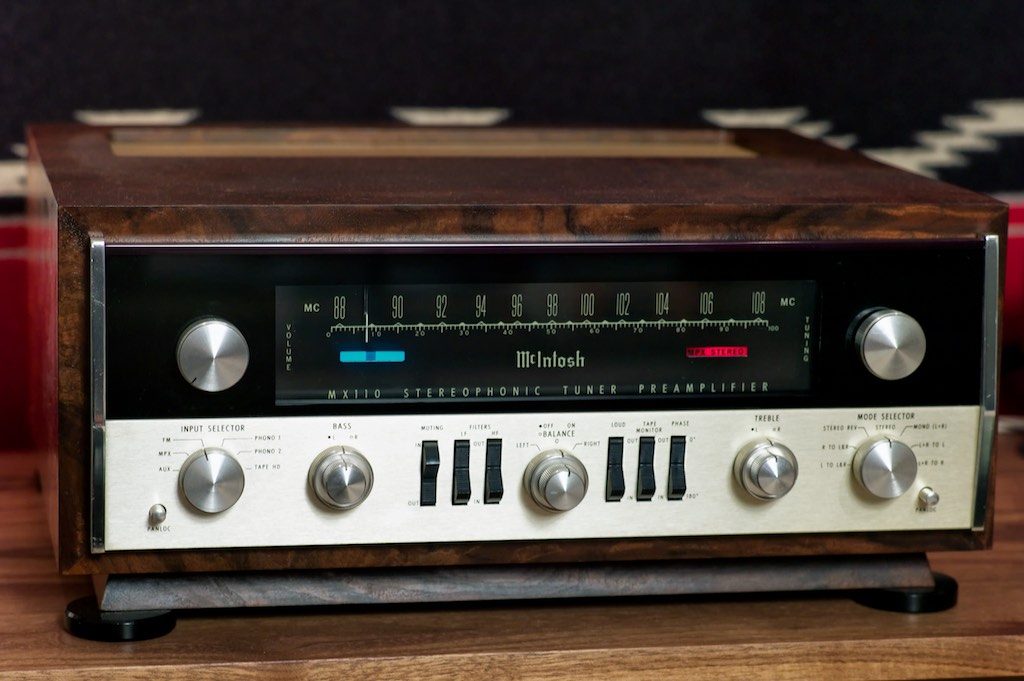
Vintage McIntosh MX110Z Tuner-Preamplifier
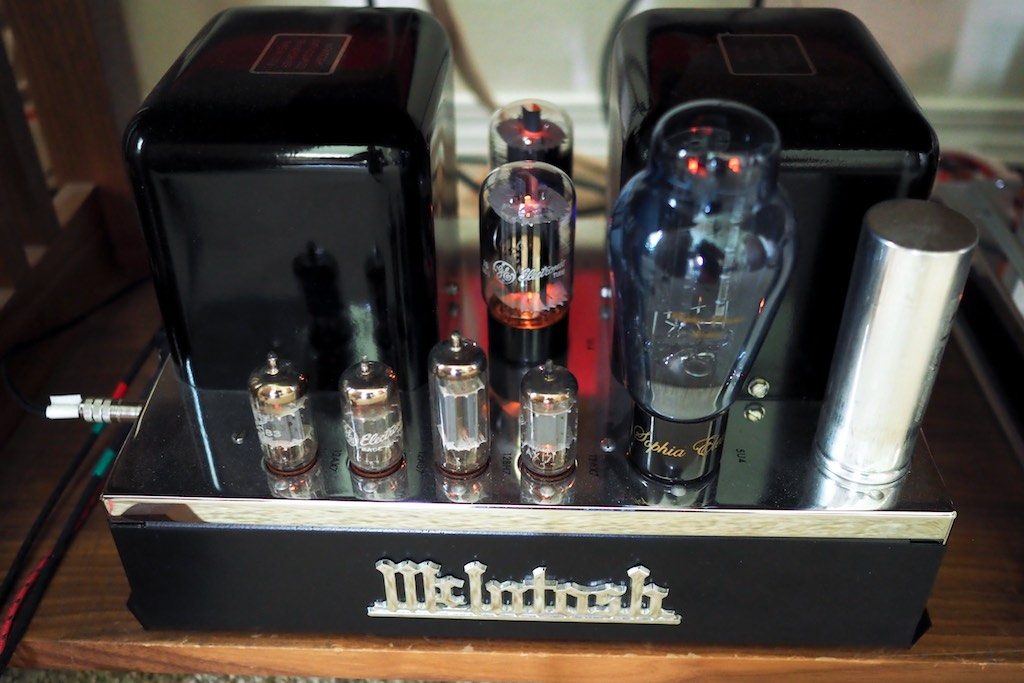
Vintage McIntosh MC30 monaural amplifiers.
A First Watt SIT-3 single-ended stereo amplifier for comparisons during reviews.
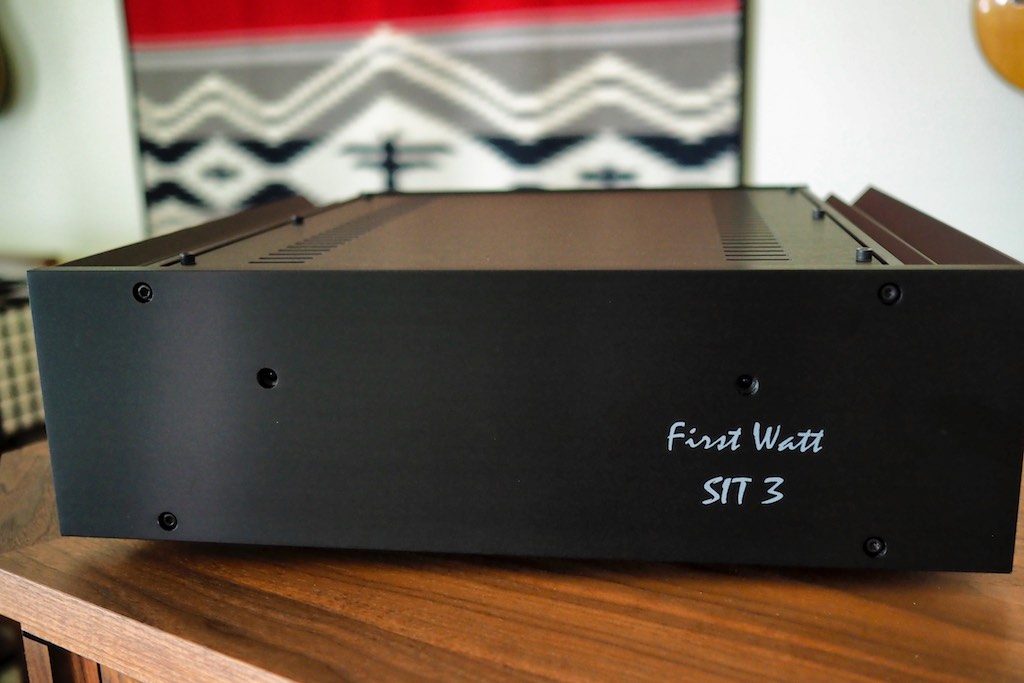
The First Watt SIT-3 stereo power amplifier.
The Pass Labs XA25 Class A push-pull stereo amplifier for comparisons during reviews.
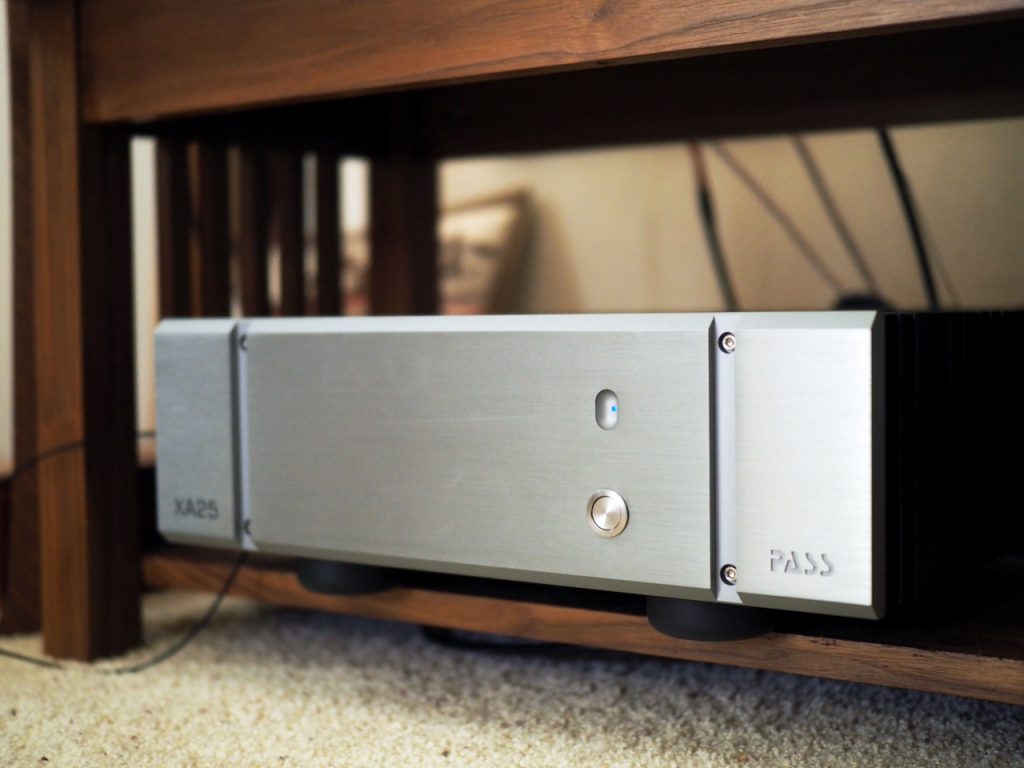
Pass Labs XA25 stereo power amplifier.
Speaker cables are Duelund DCA16GA tinned-copper speaker cables, and interconnects are Duelund DCA16GA tinned-copper cables, one pair terminated with the new Duelund plastic-free RCA connectors, and one pair terminated with the previous model of Duelund RCA connectors.
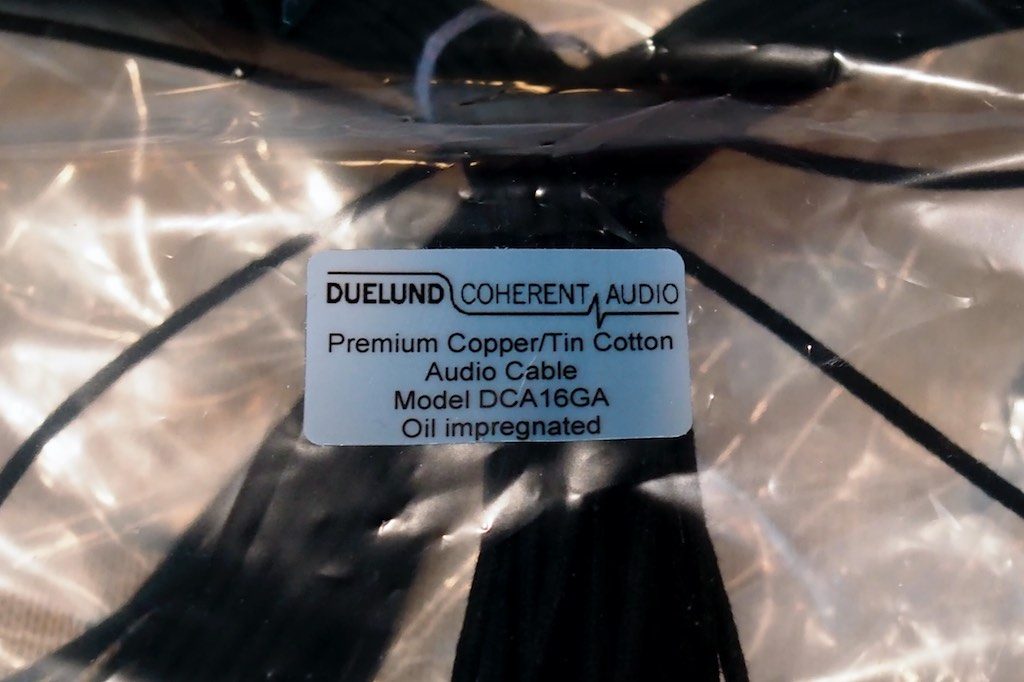
Vintage inspired Duelund DCA16GA tinned-copper wire.
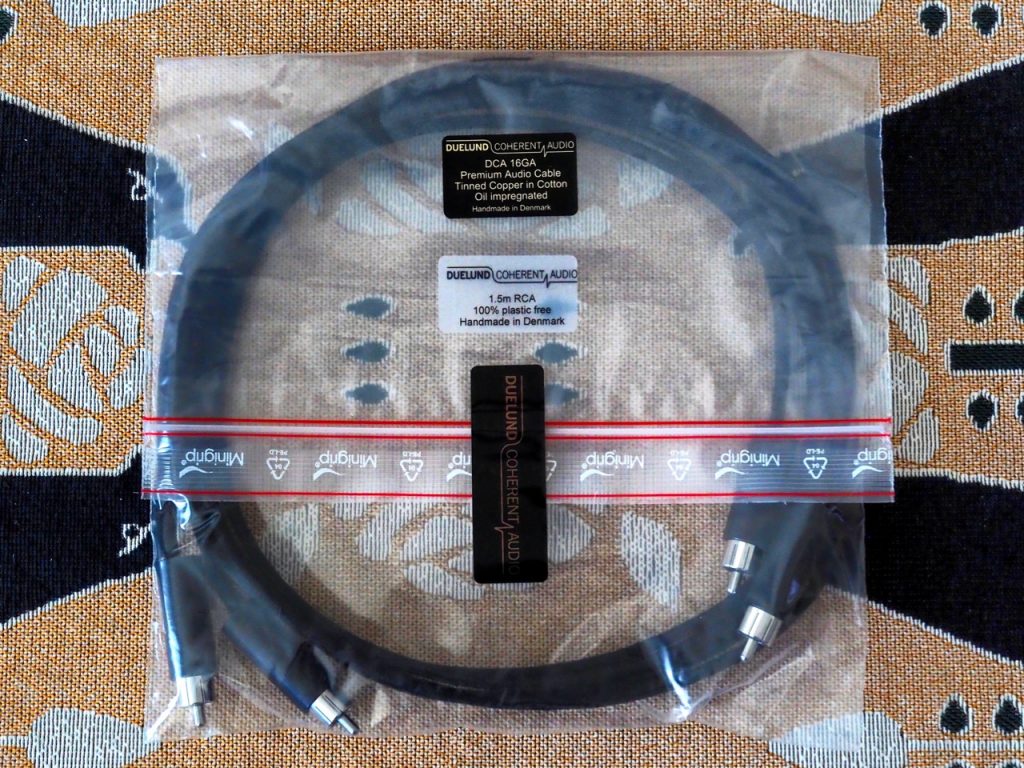
Duelund plastic free RCA DCA16GA interconnects.
I also use Acoustic Revive cable lifts for the my Duelund DCA16GA tinned-copper speaker cables.
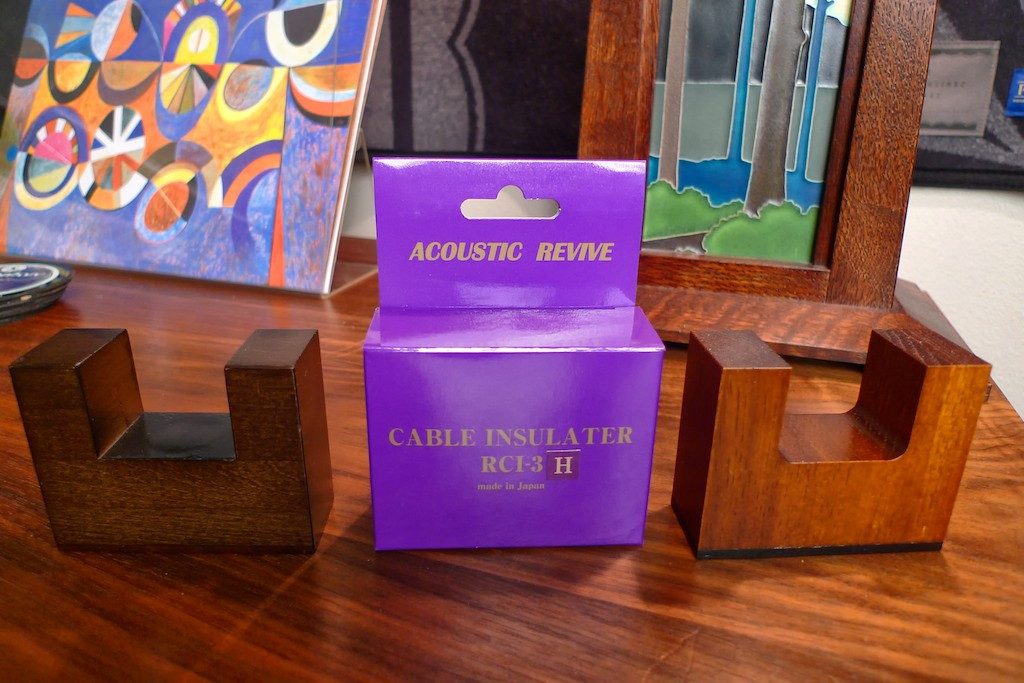
Acoustic Revive cable lifts.
My wall outlets are Acoustic Revive customized Oyaide R-1 outlets fitted with Acoustic Revive CB-1DB Receptacle Base Plates and CFRP-1F Carbon Fiber Outlet Plates.
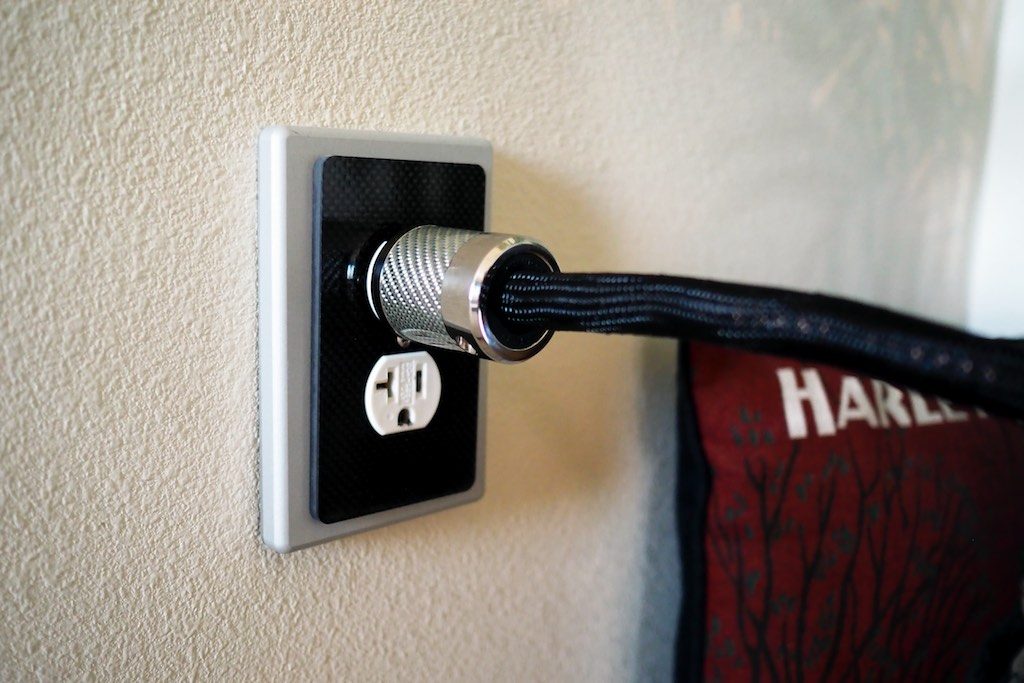
Acoustic Revive wall outlets.
From the wall outlet an Acoustic Revive Absolute Power Cable provides AC to an Acoustic Revive RPT-6 Absolute NCF Power Distributor, which distributes AC to the DAC and amplification components via Acoustic Revive Absolute Power Cables.
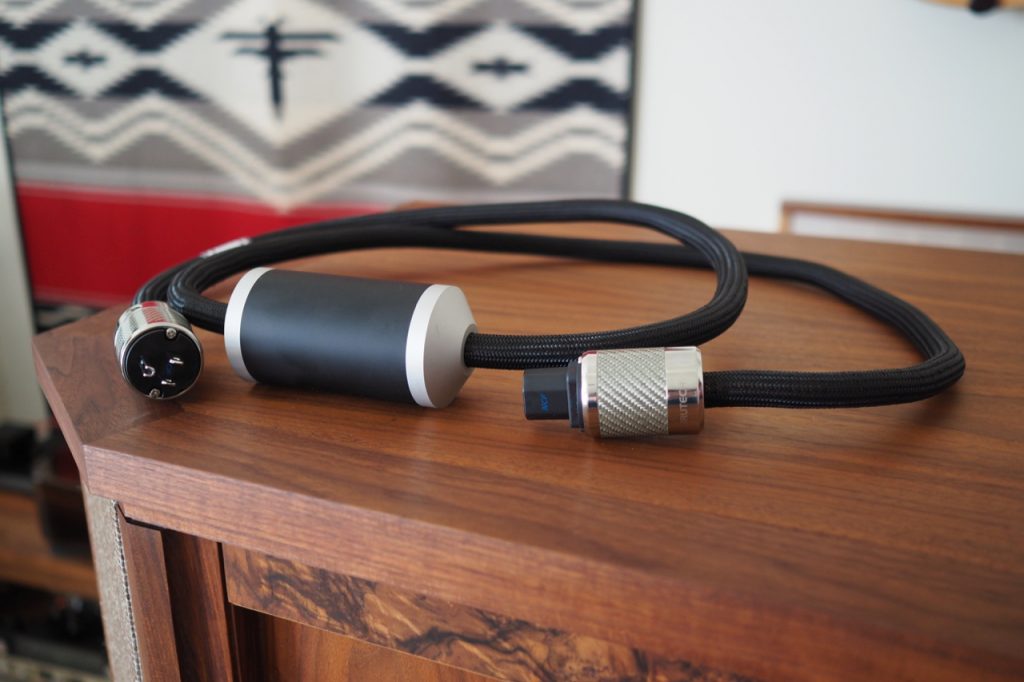
Acoustic Revive Absolute Power Cable
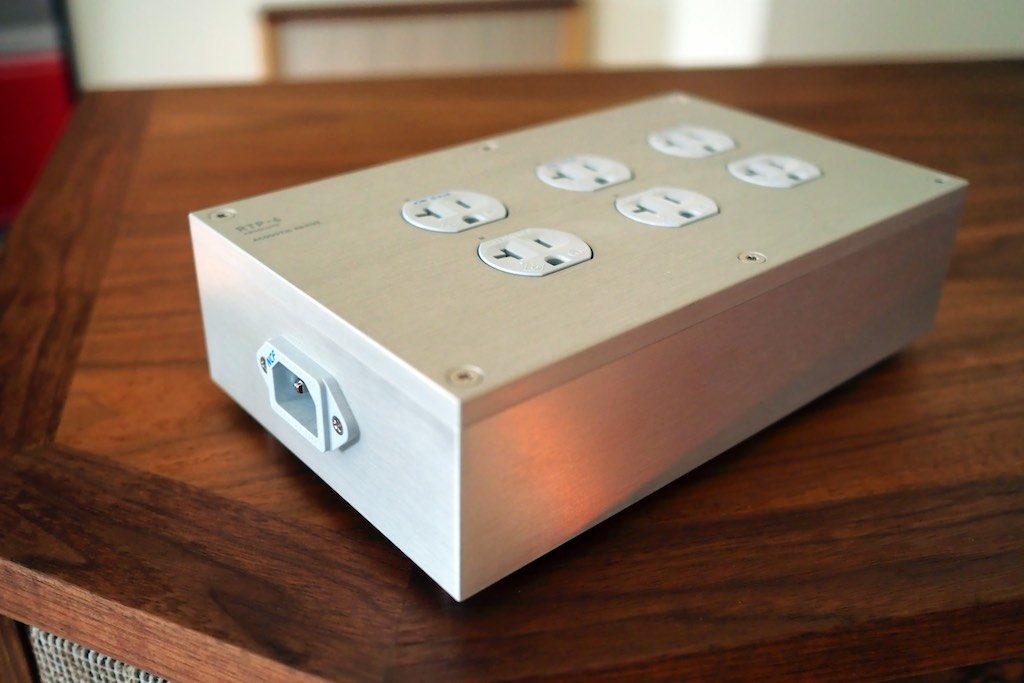
Closeup of the RPT-6 Absolute NCF Power Distributor.
My turntable connects to the Acoustic Revive RPT-6 Absolute NCF Power Distributor with a combination of an Acoustic Revive RAS-14-TripleC NCF Power Stabilizer and a Furutech G-320Ag-18 power cable.
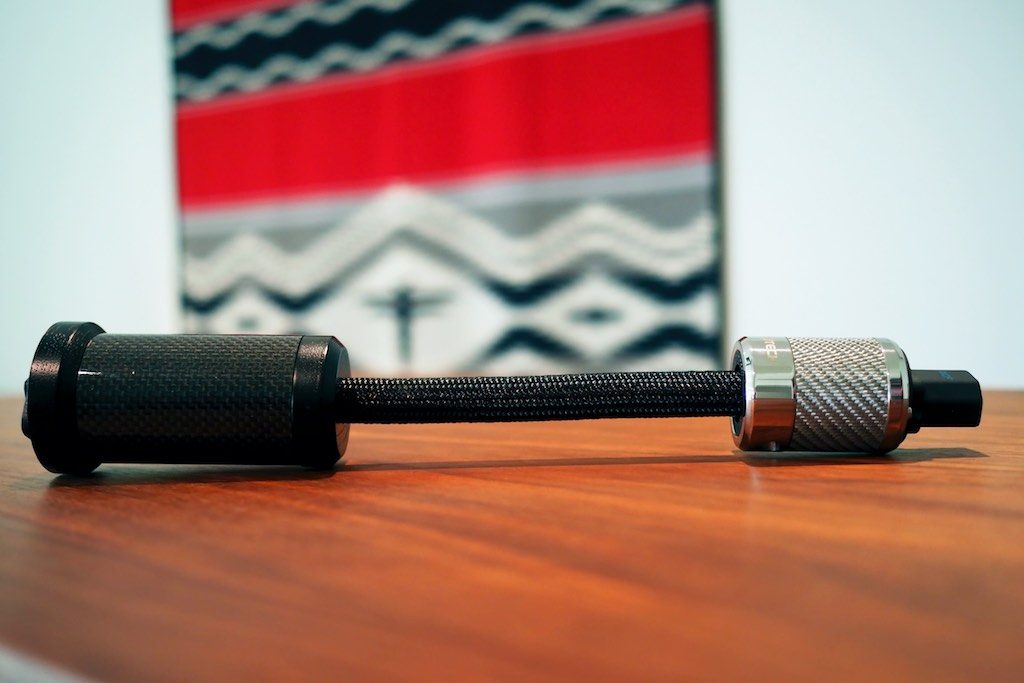
Acoustic Revive RAS-14 TripleC NCF.
Other accessories included two Acoustic Revive RWL-3 Acoustic Conditioners for room treatment, Acoustic Revive RR-77 and RR-888 Schumann Ultra Low-Frequency Pulse Generators, and Acoustic Revive Quartz Under-Boards under the Intact Audio SUTs and the Acoustic Revive RPT-6 Absolute NCF Power Distributor.
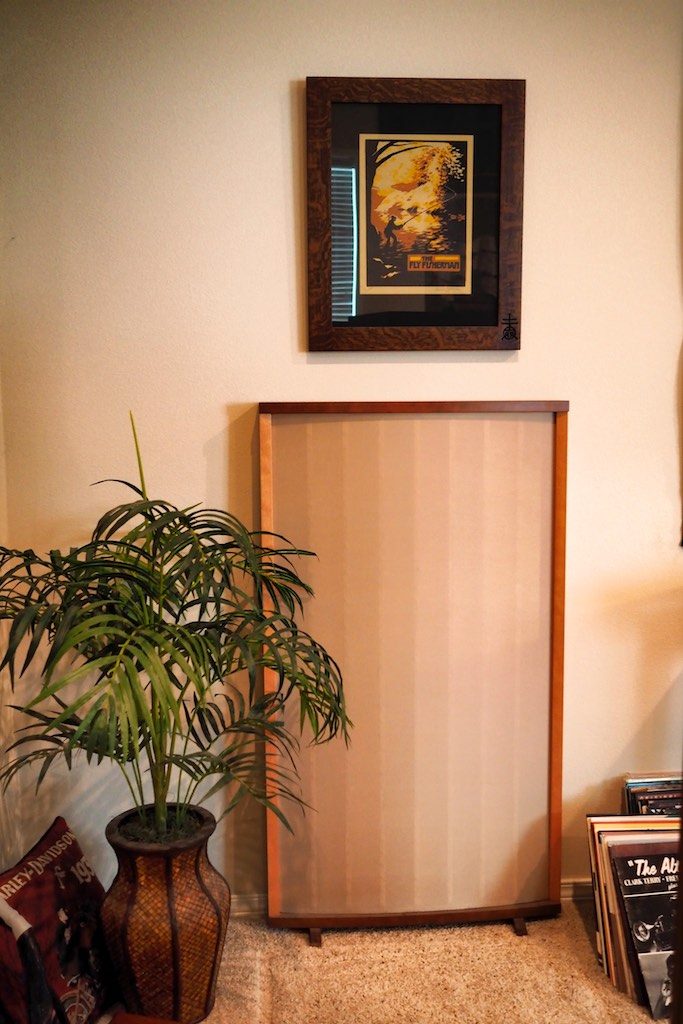
Acoustic Revive RWL-3 acoustic panel.

Left to right: RR-77, RR-777, and RR-888

Acoustic Revive RST-38 & TB-38 Quartz Under-Boards
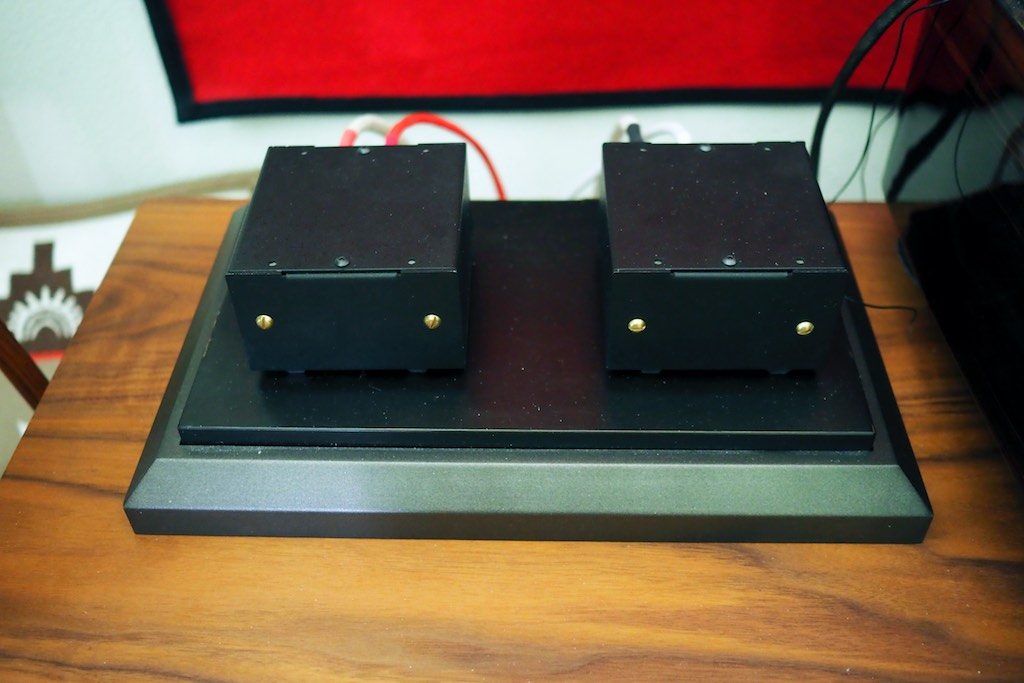
Intact Audio dual mono SUTs for the Ortofon SPU Classic GM Mk II phonograph cartridge.
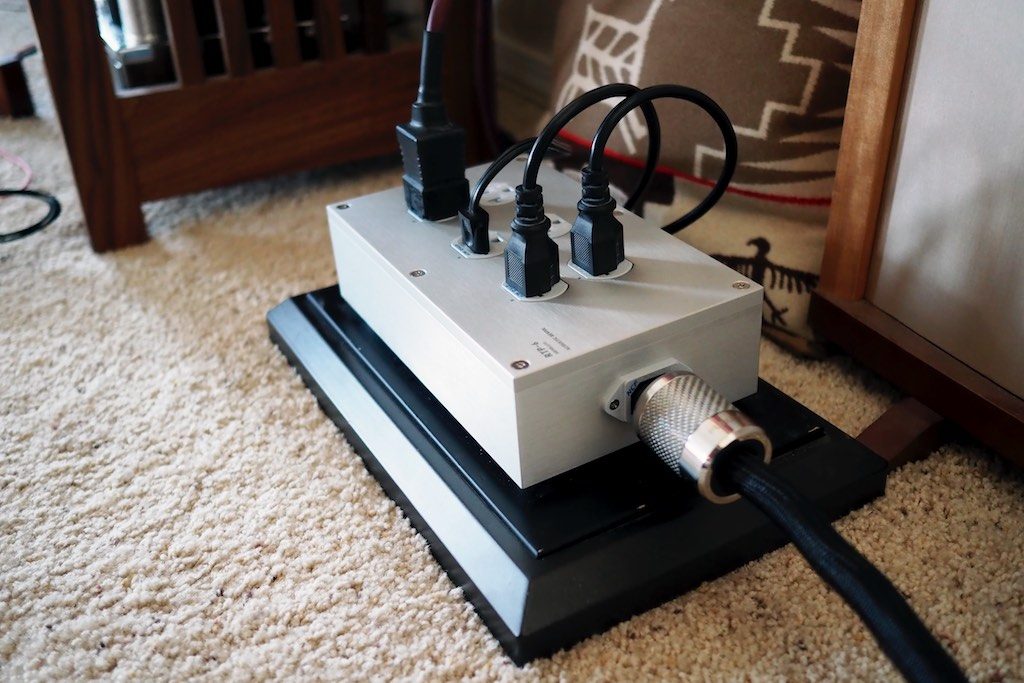
Power Reference TripleC NCF AC power cord plugged into the RPT-6 Absolute.
"Stokowski" Altec Loudspeakers Based HiFi System Summary
For reasons I'm not sure I completely understand yet, vintage Altec's are very flattering towards digital (take note digital fans), a phenomenon I've noticed with my vintage Altec 832A Corona loudspeakers, my vintage Altec A5 Voice of the Theatre loudspeakers, and my vintage "Stokowski" Altec loudspeakers.
All of my Altec's make even my relatively humble digital sources sound way better than they have any right to, and the "Stokowski" Altec's equipped with the Duelund CAST tinned-copper crossovers made my same humble digital sources sound jaw-droppingly good in a way that makes even vinyl fans like myself take notice.
The most striking aspect this system is its preternatural ability in eliciting an emotional response while listening to music.
The Duelund CAST tinned-copper crossovers are extraordinary in that regard, and whether I am listening to my humble digital front-end, my FM tuner, or my hot-rodded Garrard 301 turntable, they always draw me in and deliver a musical performance that is full of life, emotional intensity, and an intimate connection to the music.
The ability of this "Stokowski" Altec based system to draw me in as listener, provide a high level of emotional impact, and consistently deliver an intense musical experience from any source, is their most dominant trait.
This aspect of the system's performance meant I could just get lost in the wave of the music flowing over me, marveling at what I was hearing and feeling to such an extent that my critical faculties just abandoned me, and it didn't matter if I was listening to jazz, rock & roll, blues, classical, or what have you, they all affected me the same intense way with Duelund-ized Altec's.
While the elements of musicality and sonics are really superb with the Duelund-ized "Stokowski" Altec's, their ability to elicit a strong emotional response while listening to music is this system's most distinctive trait, and what separates it from anything else out there I've heard in terms of overall performance.
There are certain aspects of the combined performance of the Duelund CAST tinned-copper crossovers and the "Stokowski" Altec's that are truly extraordinary and contribute to their ability to elicit an emotional response; like their ability to play comfortably and naturally at soft levels all the way up to realistic live-like volumes; or their immense ease in playing in a dynamically realistic live-like fashion across the dynamic spectrum, from the subtlest dynamic nuances that made melodies come alive, to those big dynamic hits that make you jump; and their ability to portray realistic and believable timbral textures, tempo, and beat, was truly superb, all of which work together to make them the most consistently emotionally engaging and musically satisfying combination of crossovers & loudspeakers I've ever heard.
With the Duelund CAST tinned-copper crossovers and "Stokowski" Altec's brass sounded vividly and colorfully present, yet was still rich and natural in timbre. It was easy to hear the nuance of strikes on drum heads and cymbals, and to hear how they interacted with the acoustic space around them. Upright bass strings sounded rich, full bodied, and mellow, just like the real thing. Jazz guitar sounded like it was in the room with me. Piano sparkled with life and color, and the way the tones decayed from bursts of color into darkness was life-like, gorgeous, and spellbinding.
Musical instruments and vocals sound superbly natural and vividly present, and there is always a sense of beautifully realistic instrumental and vocal tone. Unnatural edge to horns or unnatural sounding vocal sibilance simply doesn't exist in the Duelund-ized Altec's world, and music sounded utterly natural in tone and timbre.
This "Stokowski" Altec's based system presents visuospatial information in such a naturally artful and live-like way that it contributes significantly to their ability to elicit a strong emotional response from me, and the visuospatial information is presented in such a way that it lets the music unfold in a flowing and natural manner.
Images are vivid in their presence, have a robust "flesh and blood" feel of body that makes images sound and "feel" natural.
The soundstage is presented as wide, deep, and with distinct layering back into the stage, to the extent that recording was able to provide it, but perhaps the most notable trait from a sonic perspective is this systems ability to suffuse the soundstage with a sense of the natural acoustic of the recorded space that engulfs my listening room.
Overtones go on forever, there is life, light, and color in the acoustic of the recorded space. I am simply there at the venue with the musicians, or they were in my room with me, depending on the style of the recording, which altogether created a very strong sense of being part of the music-making experience.
Bob James Quartet live at Jazz Alley in Seattle
One last thing I might add is how naturally "live" this hifi system with the Duelund-ized "Stokowski" Altec's sound with the Duelund CAST tinned-copper crossovers, and by "live" I don't mean an exaggerated sense of upper-midrange presence that is often meant when that term is used.
Reduta Jazz Club in Prague
Rather, I mean "live" as in sitting in a live venue when listening to jazz, for example, like at Jazz Alley in Seattle or at the Reduta Jazz Club in Prague.
Nerdy audio nut that I am, I have done Real Time Analysis (RTA) of live performances in both Jazz Alley in Seattle and the Reduta Jazz Club in Prague, and when I do that same RTA of the "Stokowski" Altec's in my living room the result is remarkably similar to the live RTA results in those venues.
The "Stokowski" Altec's don't sound like loudspeakers that are voiced to appeal to audiophiles who like exaggerated visuospatial information.
Rather, they sound like what they were intended to sound like by Dr. Stokowski: loudspeakers that sound very much like the music he heard with his orchestras playing live music, and fine tuning his audio equipment to sound as much like "live" as possible.
So, the "Stokowski" Altec's with their Duelund CAST tinned-copper crossovers sound very "live" in the sense of live music playing in a music venue that has the reverb time dialed in perfectly, which means that the music playing in my living room sounds naturally live, tonally & dynamically correct, emotionally engaging, and makes me feel like I'm part of the live music making, which at the end of the day is what it is all about for me.
I think that's a pretty good summation of the strengths I hear from the this system based on the Duelund-ized "Stokowski" Altec's, whether I'm streaming jazz from my digital front-end, listening to classical on my FM tuner, or doing late-night listening with vinyl.

The Duelund-ized Altec's remind me of when I first saw Vincent van Gogh's 1889 painting The Starry Night while it was on display at the National Gallery of Art in Washington, D.C. circa 1997. The Starry Night painting looked so different from any of the prints or photographs I had seen of it. It seemed to be alive, moving with feeling and color before my eyes, it was dramatic, forceful, and it completely captured my attention, awe, and admiration. The Starry Night exerted a power over me that was almost disorienting.
That's exactly the way the Duelund CAST tinned-copper crossovers installed into the "Stokowski" Altec's affected me when I listened to music with them. They were alive with music, moving with feeling and color before my ears. Dramatically, forcefully, engrossing me as a listener, filling me with awe and admiration for the music as it played before me, around me, and in me. Truly these are something special in the world of hifi!
I'll update this page periodically as the equipment in the "Stokowski" Altec system changes.
Since I wrote the above, things have changed a lot with these loudspeakers, and you can read all about it on the next page.
Update: The Latest With the "Stokowski" Altec System - State Of The Systems Report: Office Nirvana!
Click HERE to go to the "update" page.
As always, thanks for stopping by, and may the tone be with you!





